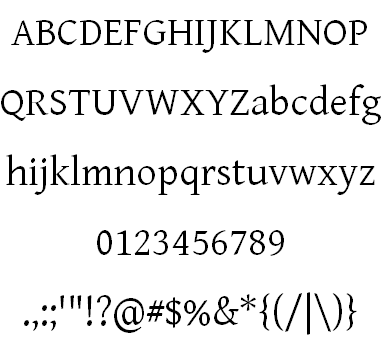
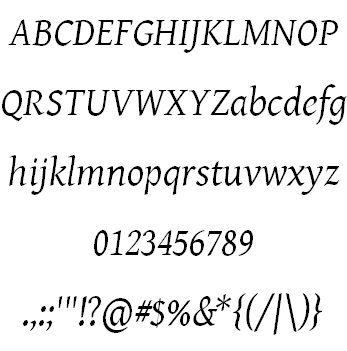
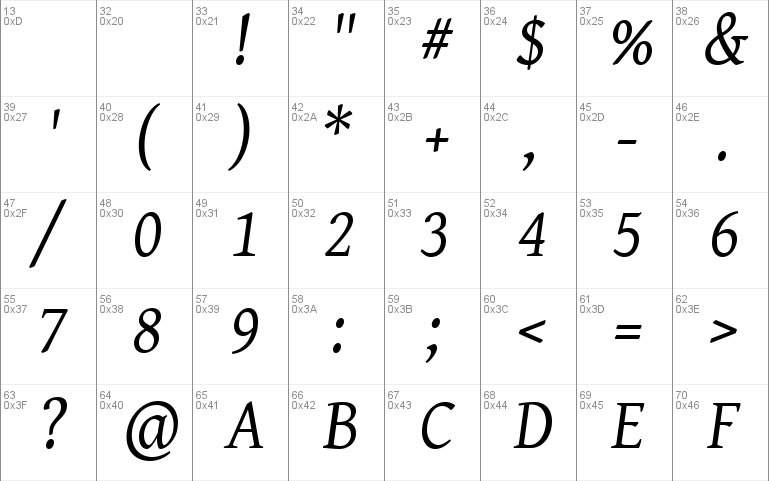
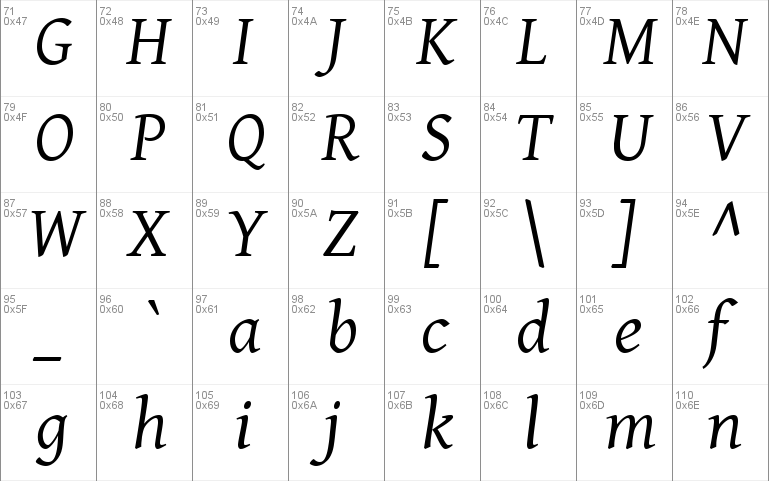
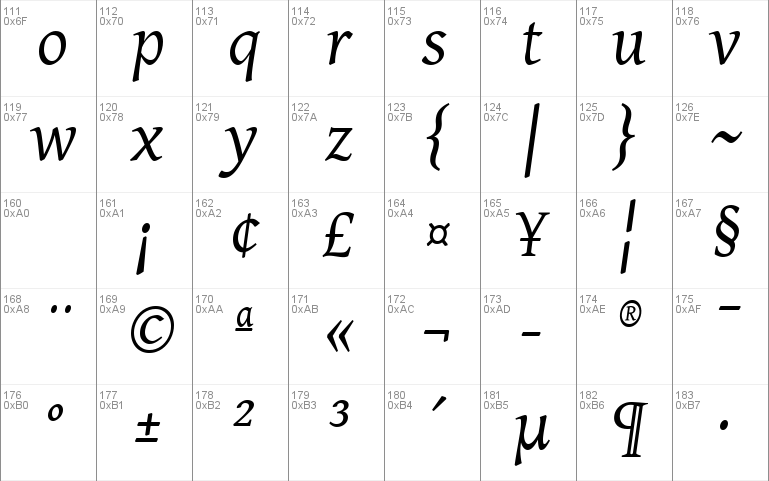
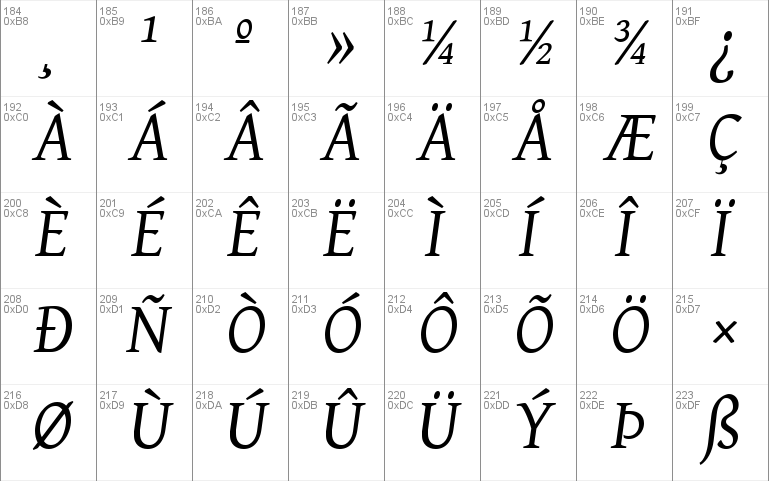
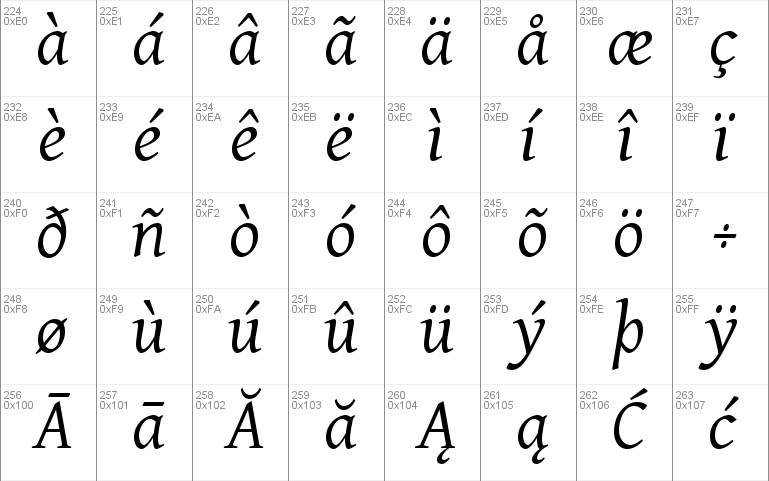
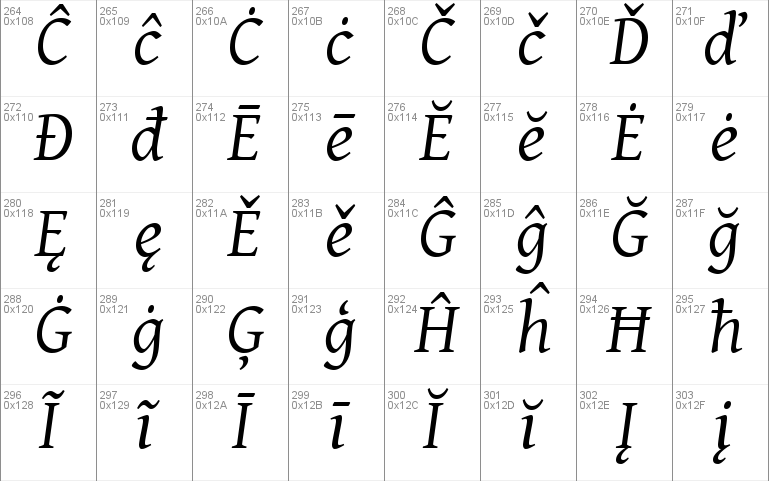
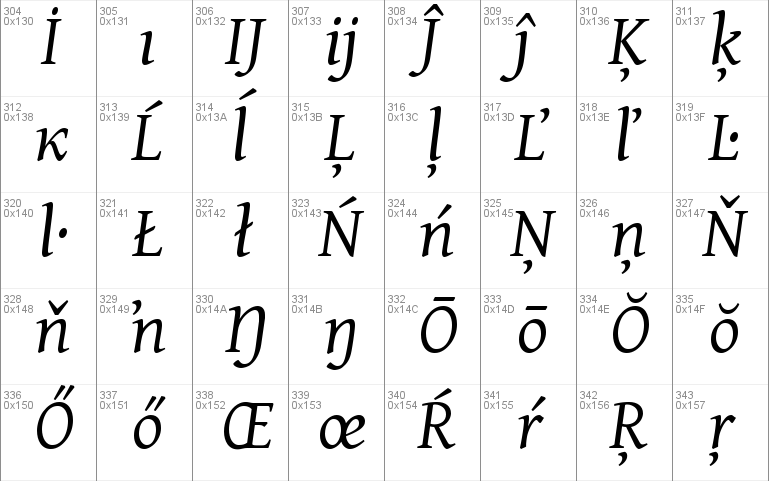
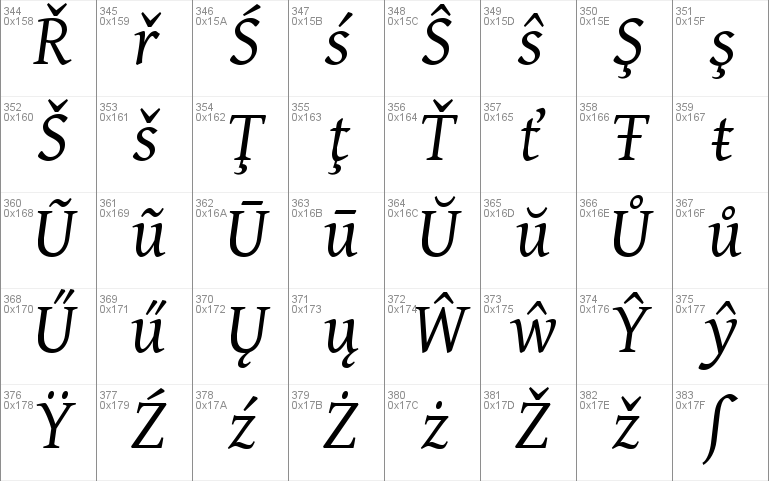
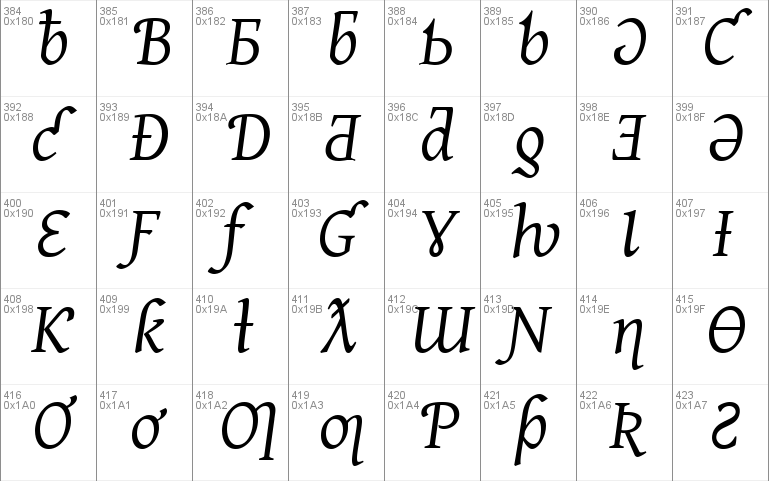
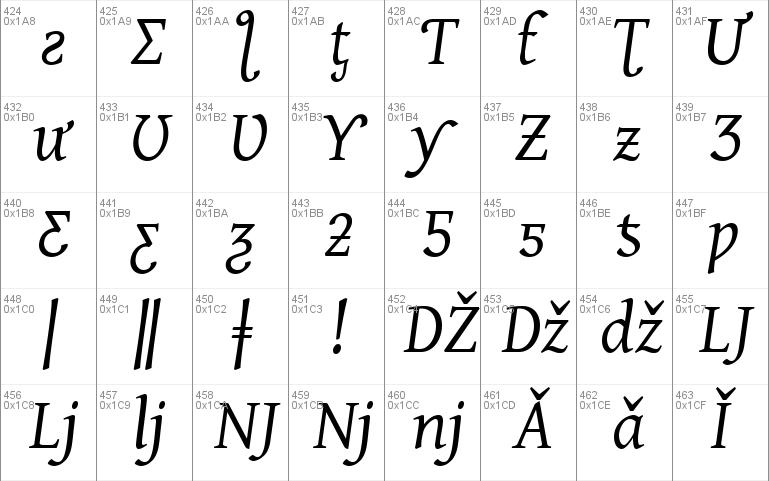
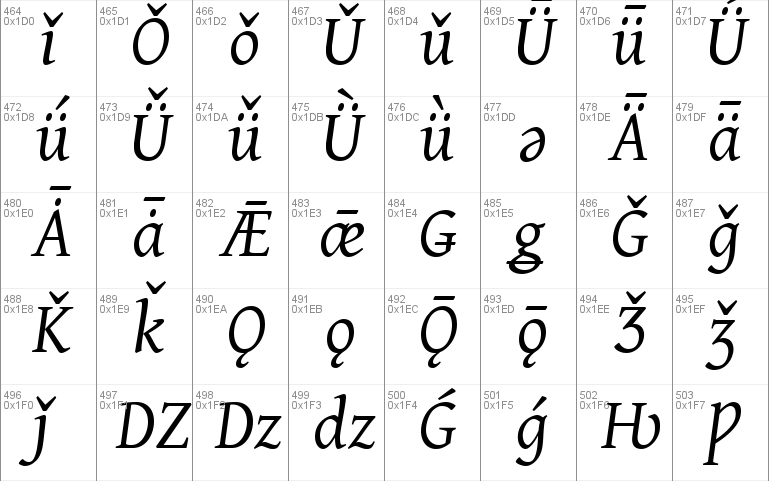
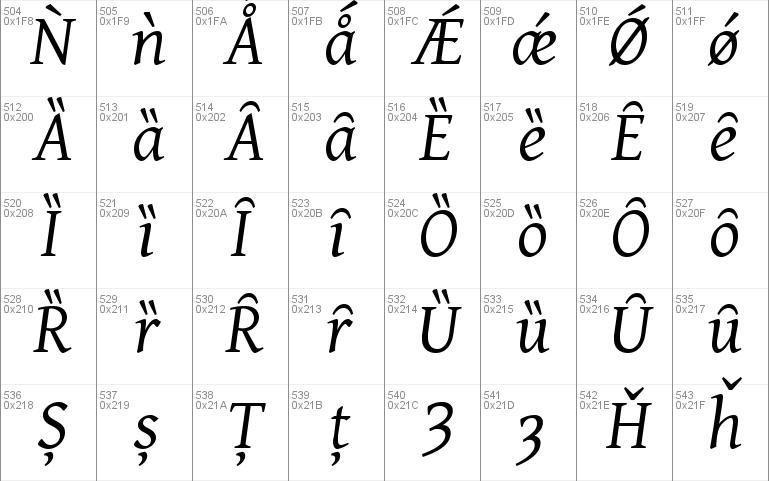
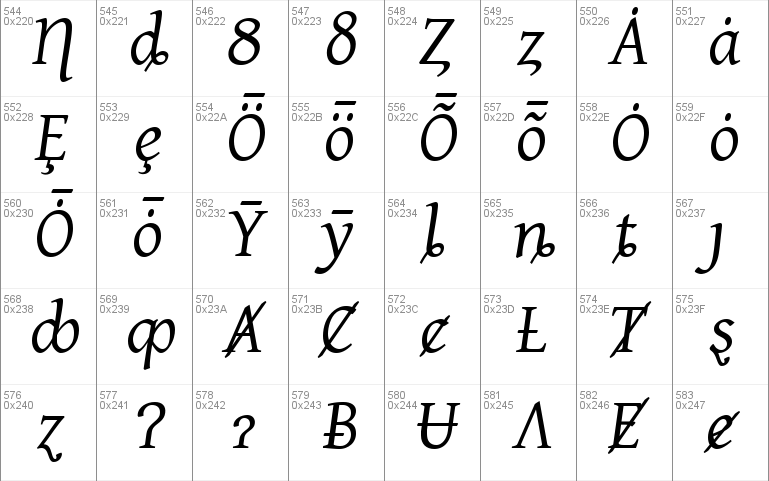
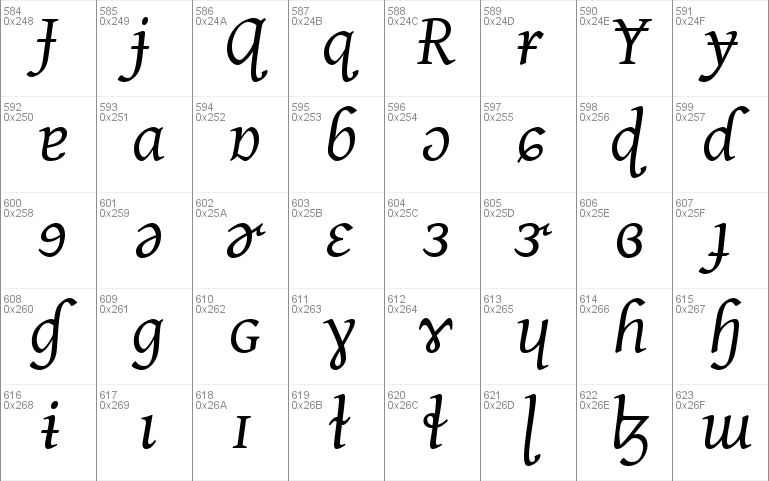
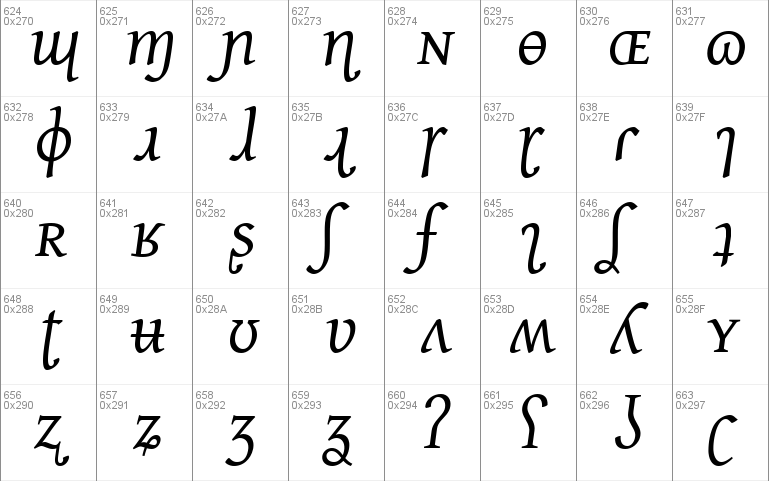
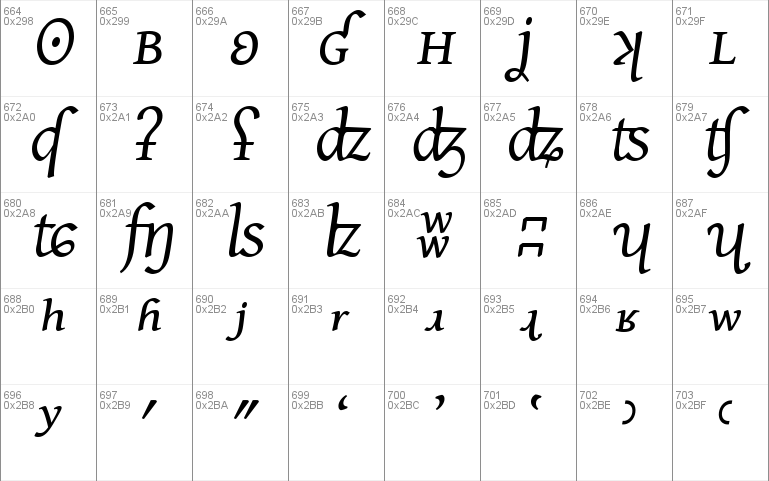
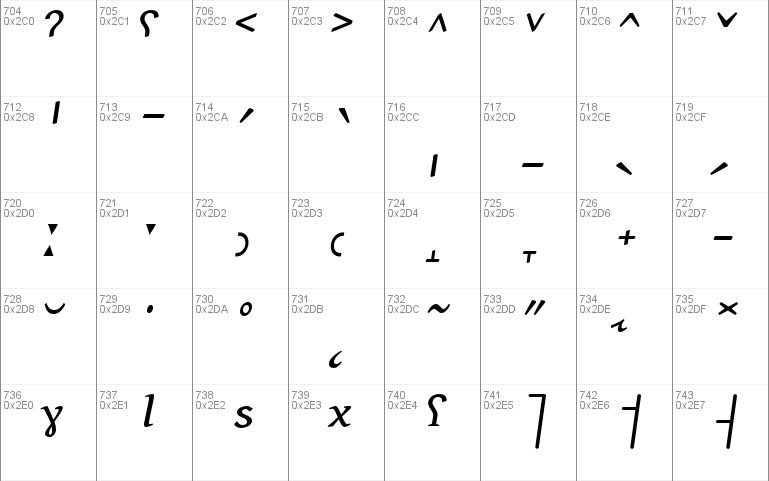
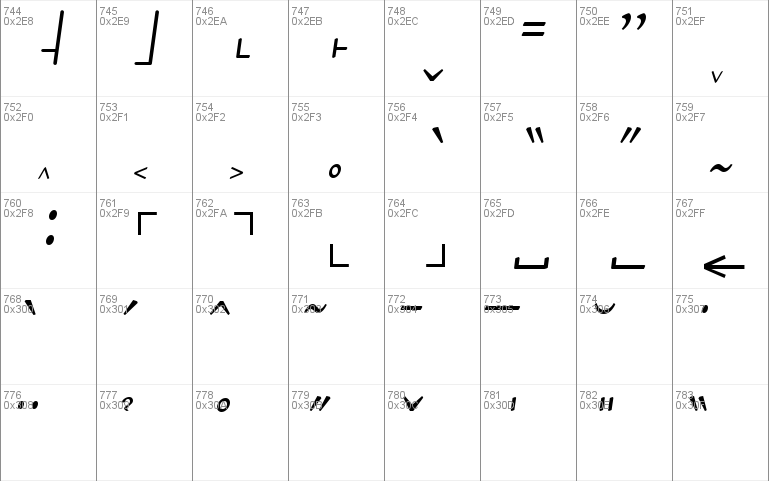
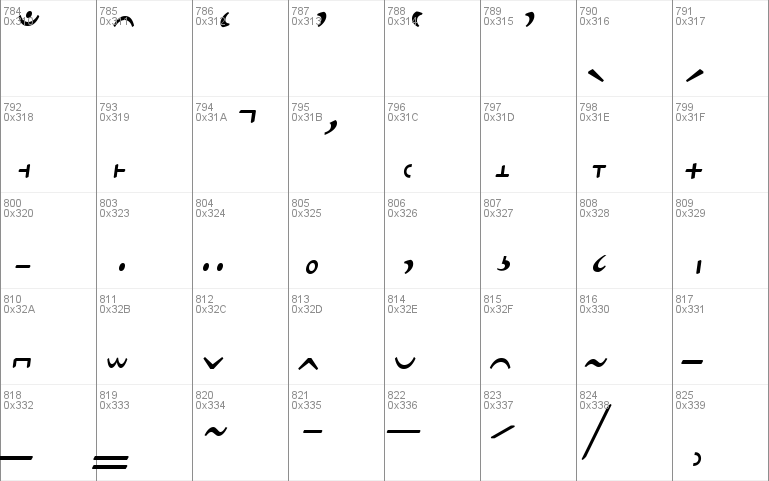
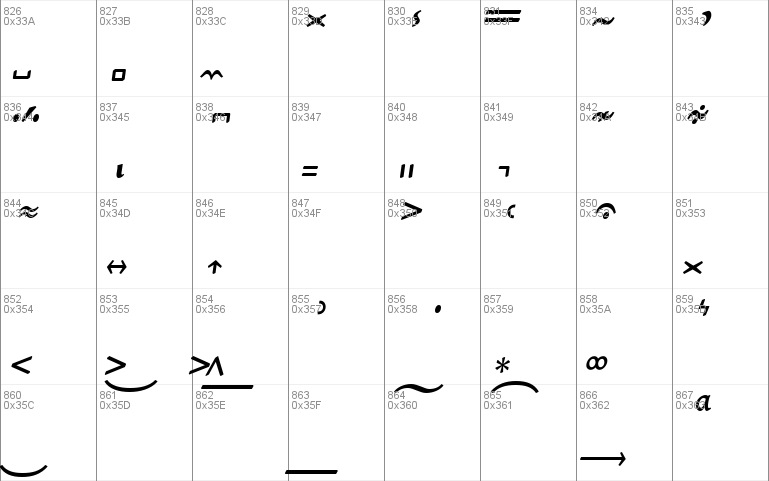
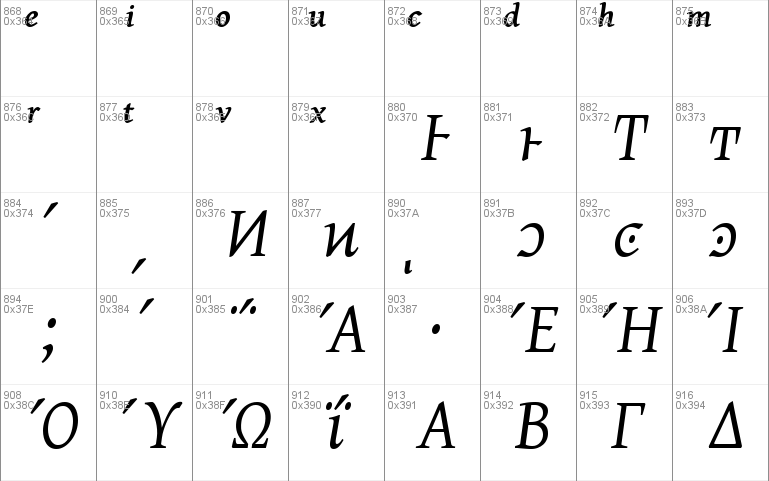
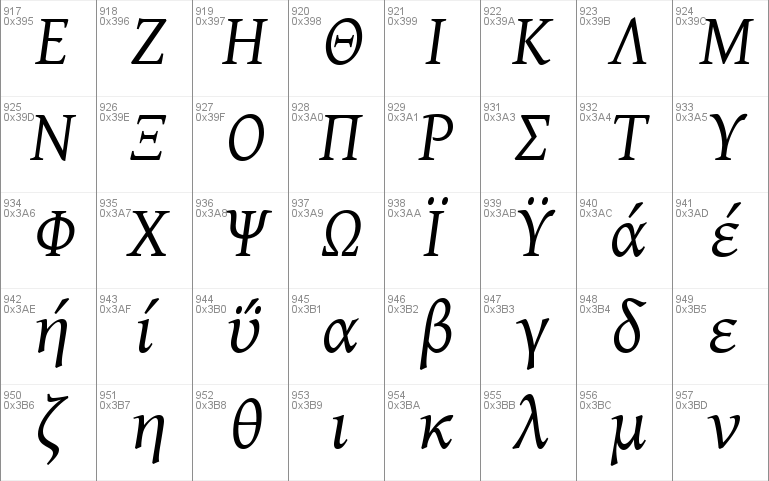
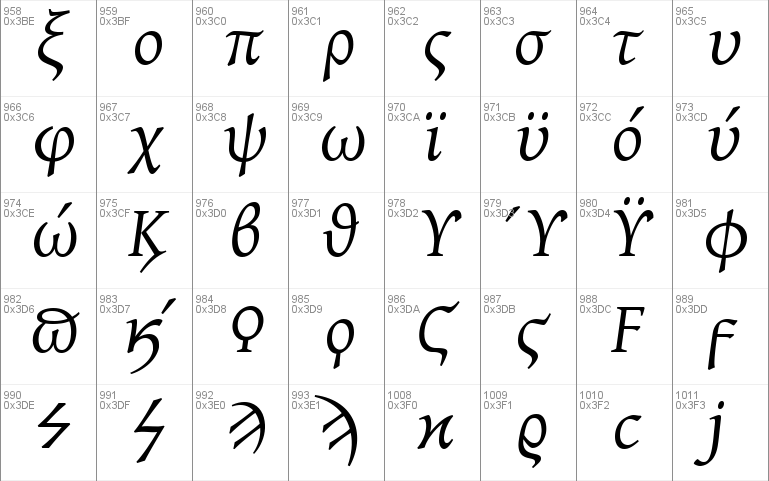
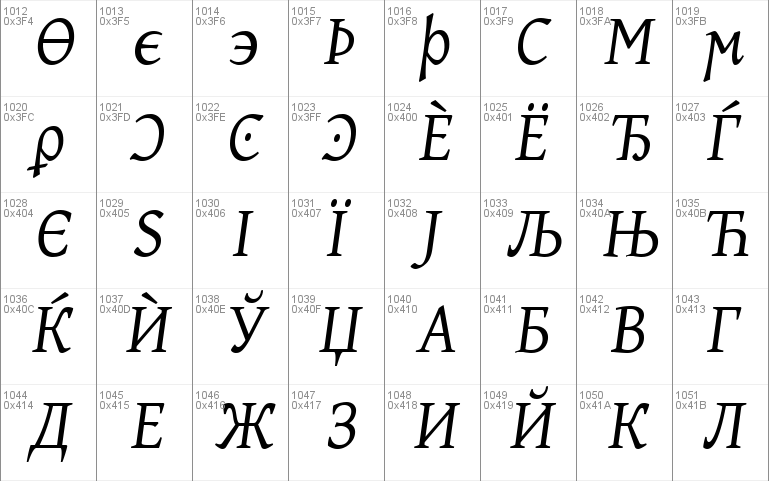
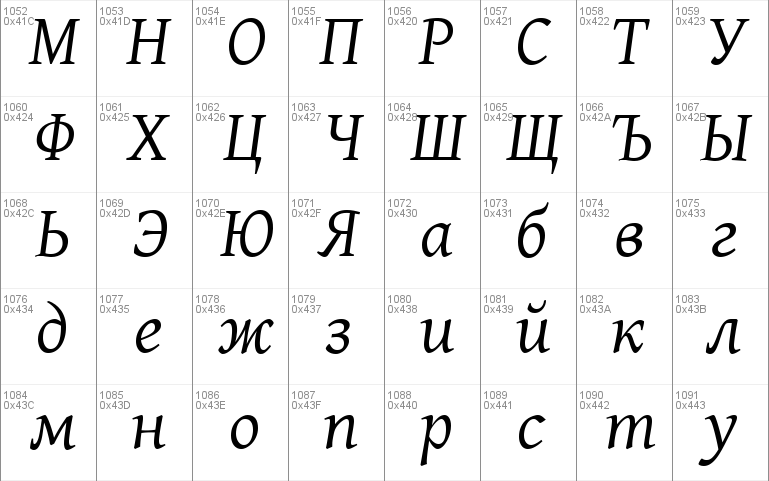
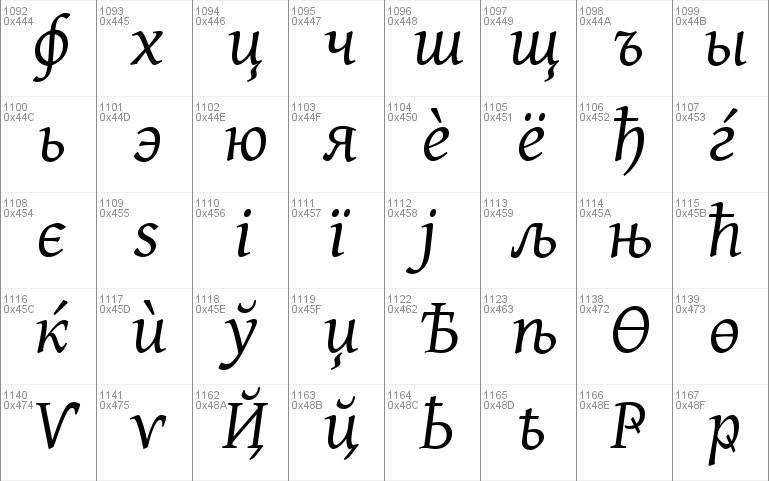
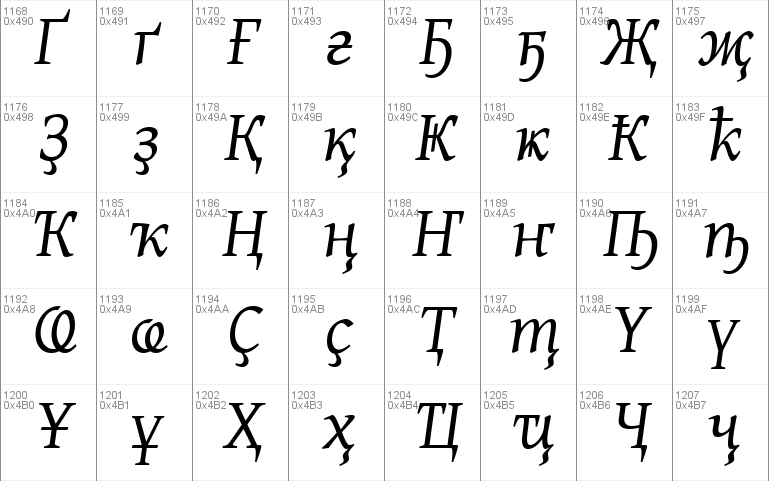
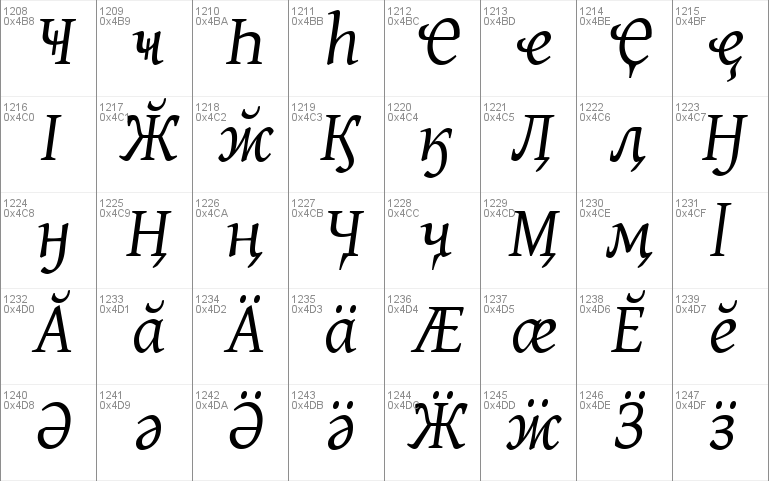
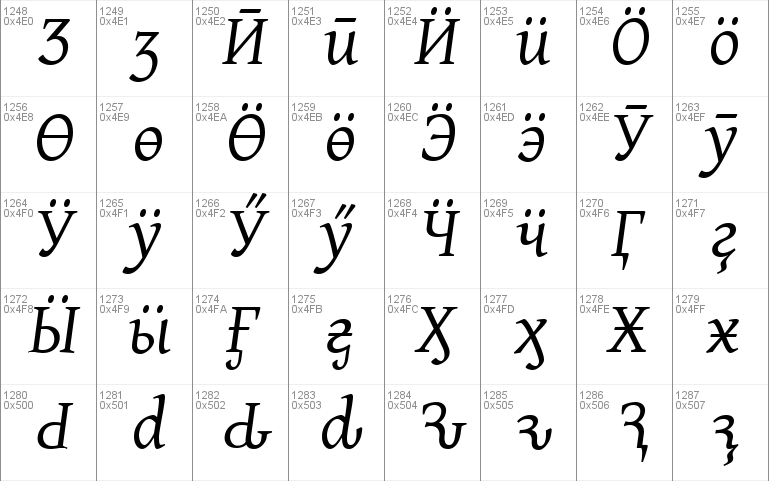
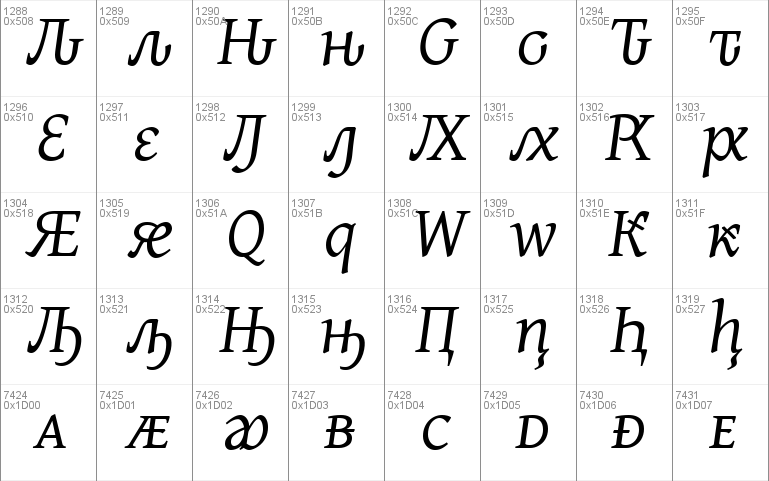
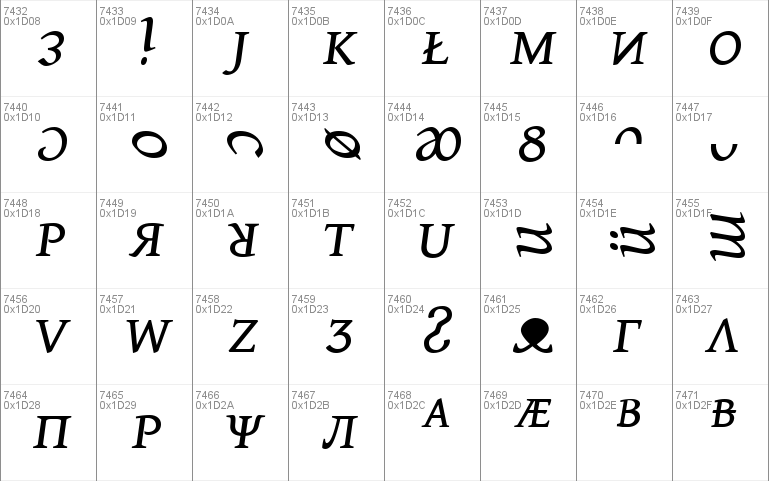
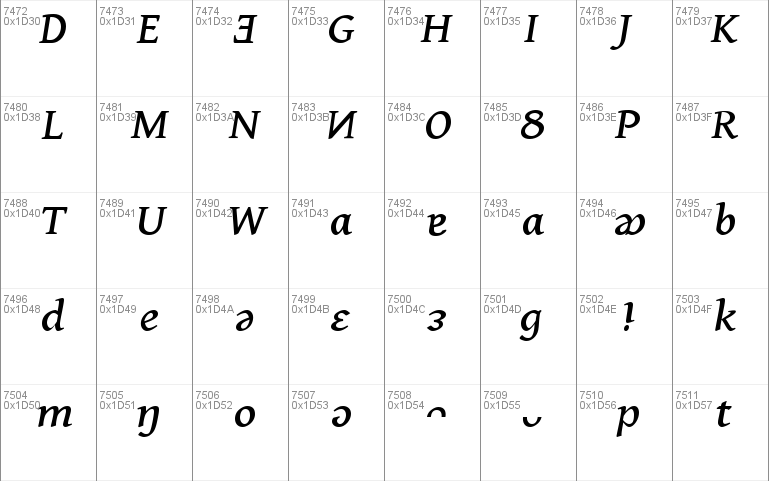
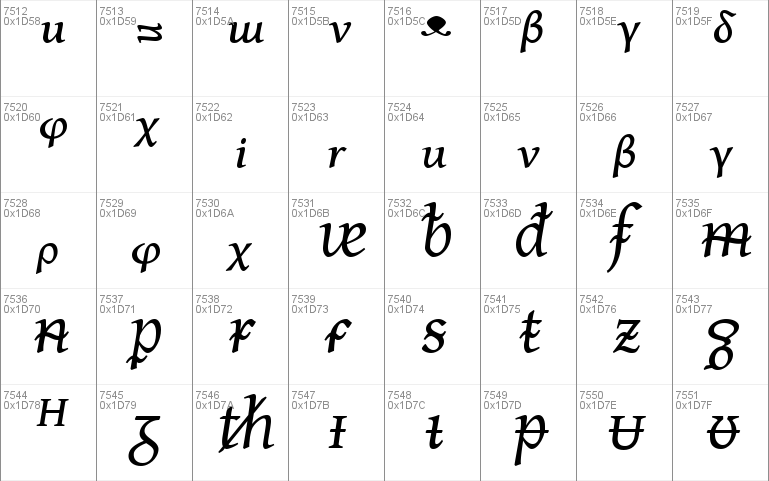
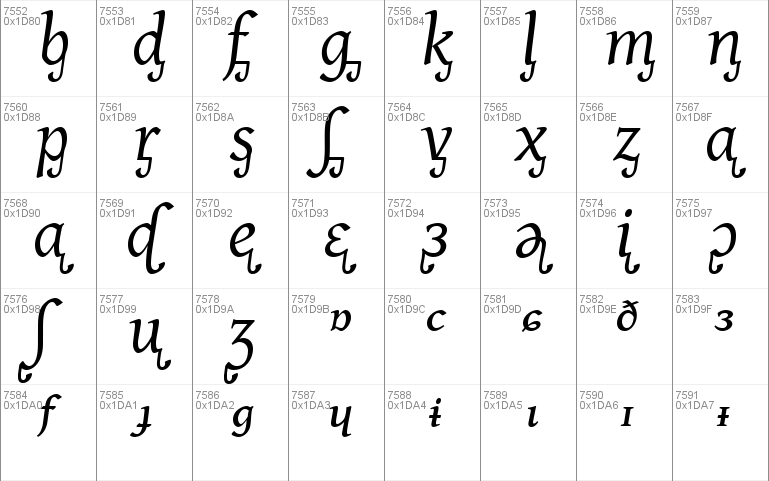
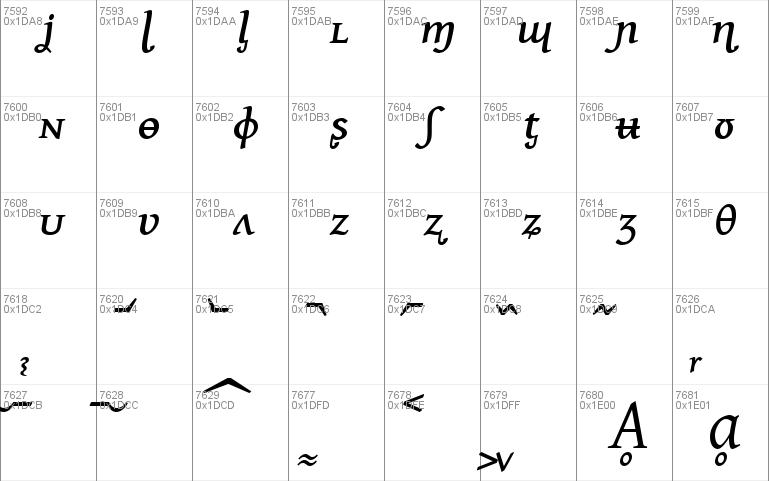
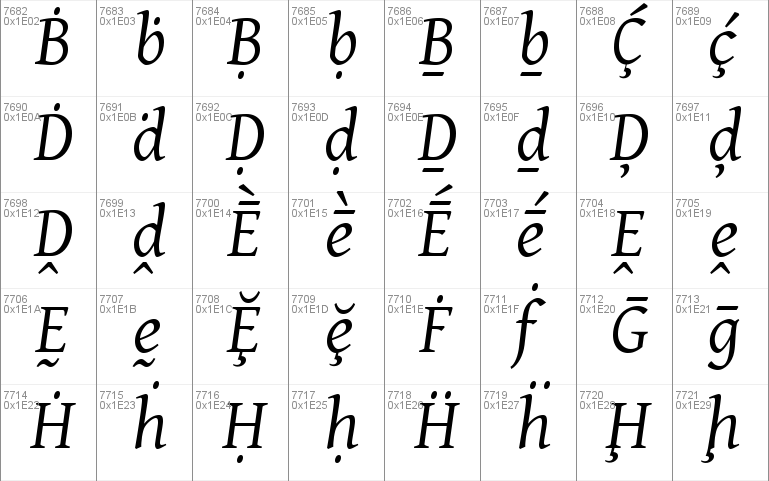
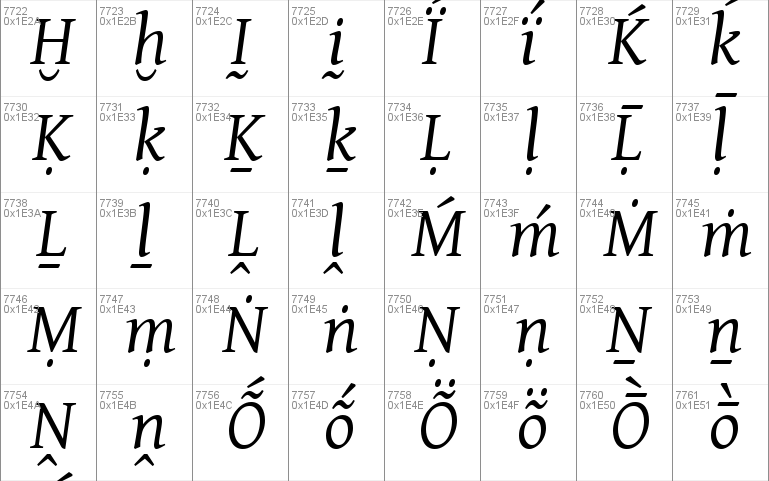
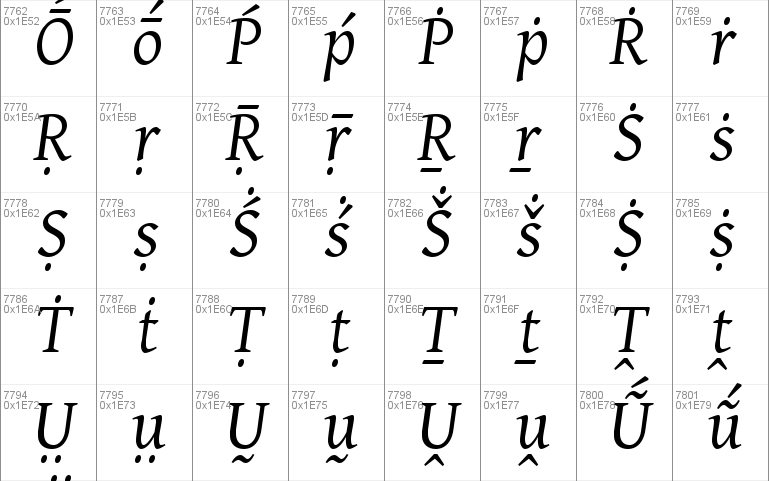
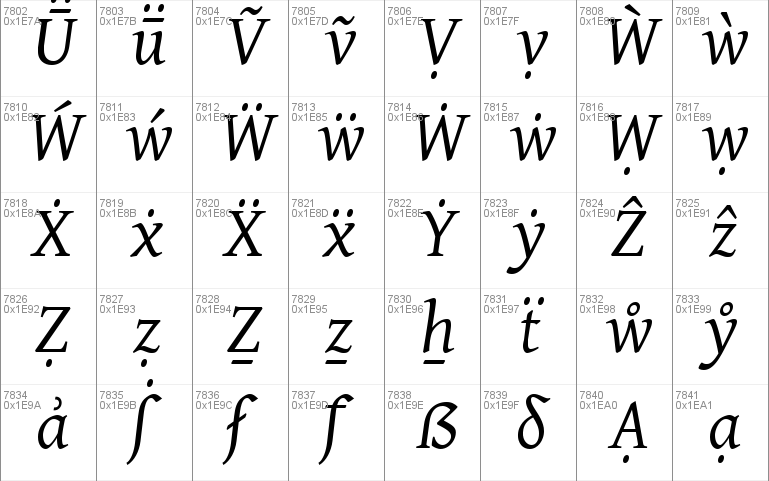
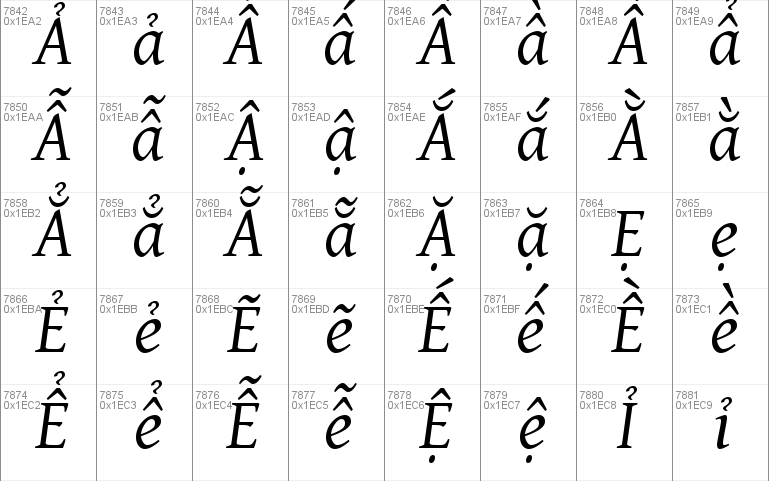
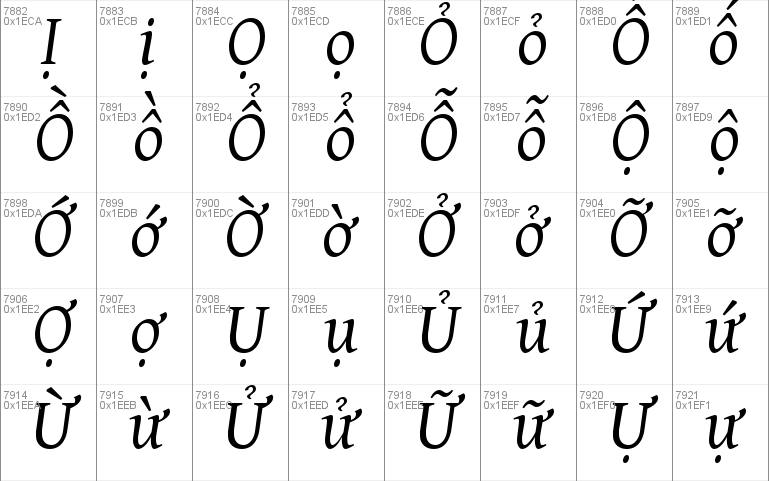
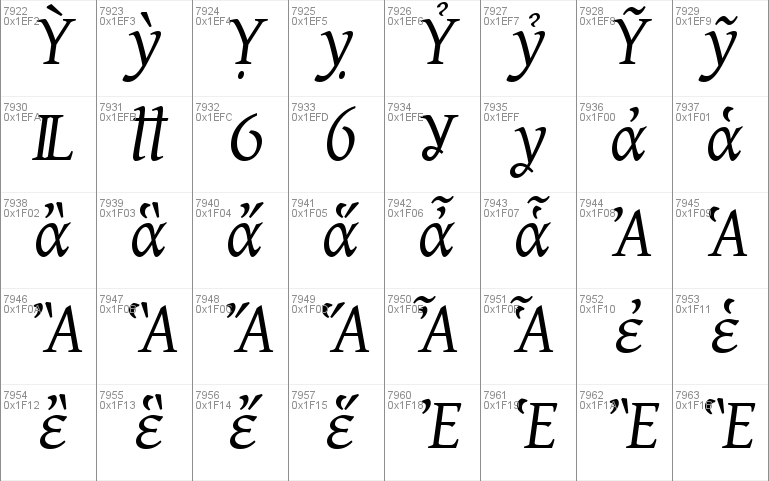
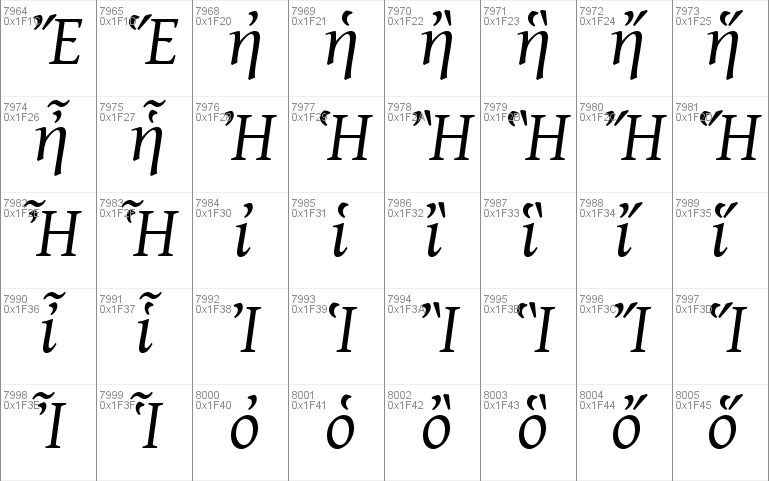
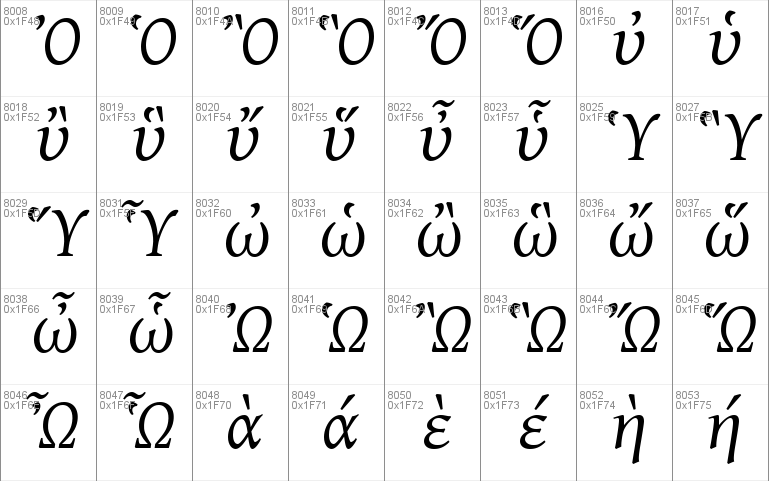
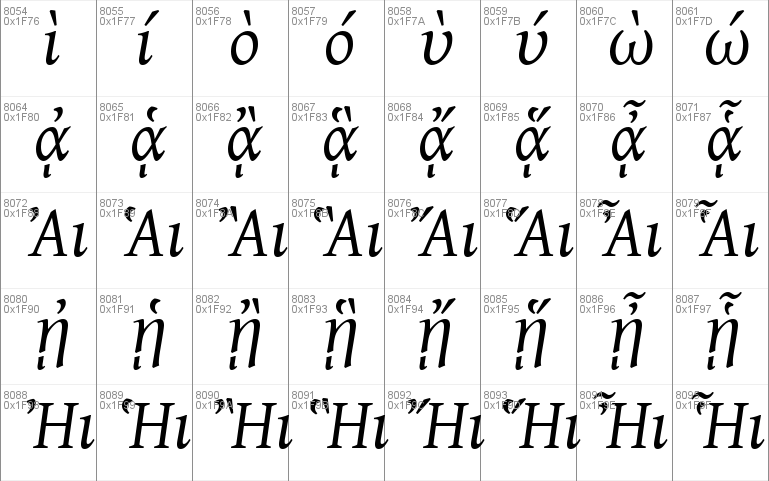
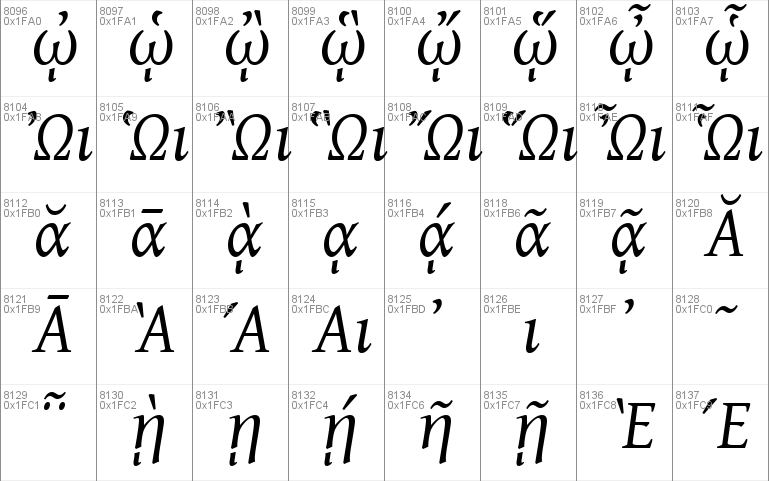
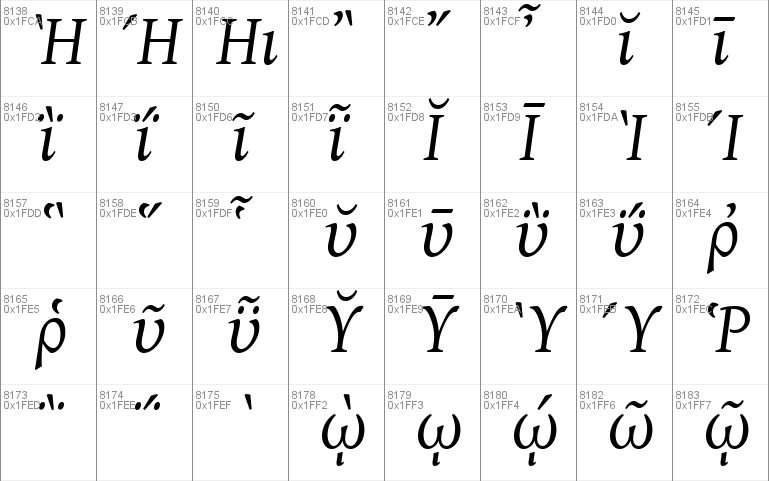
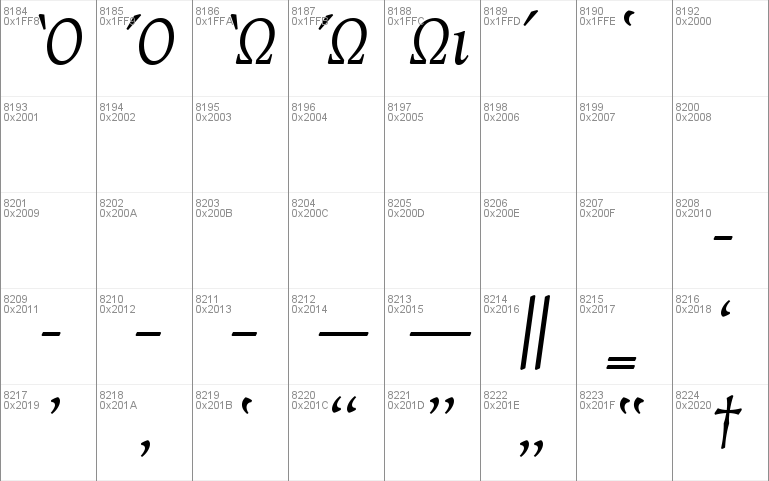
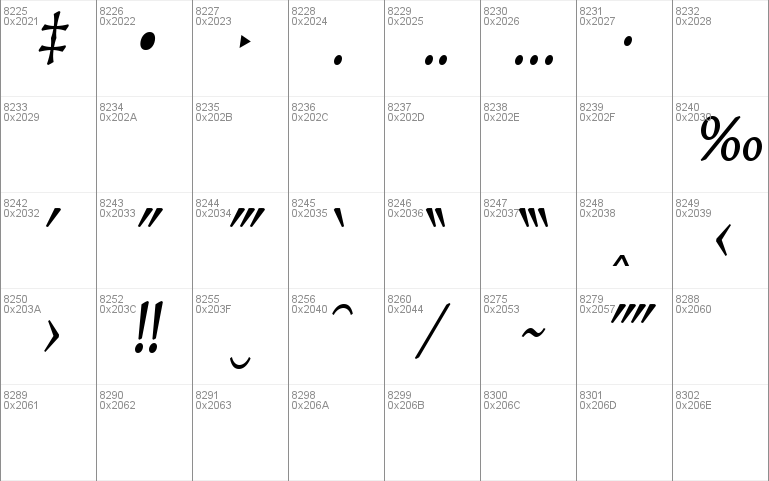
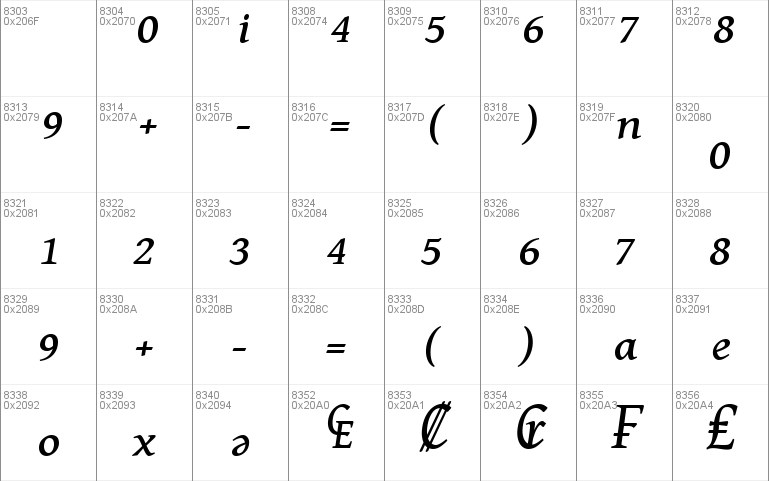
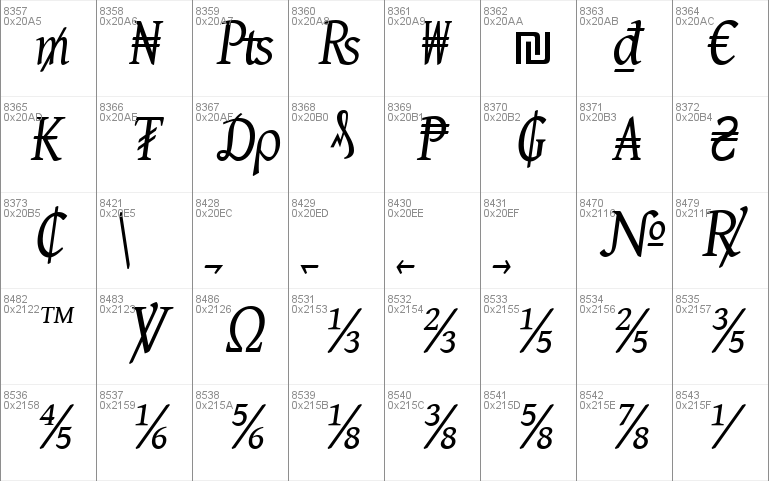
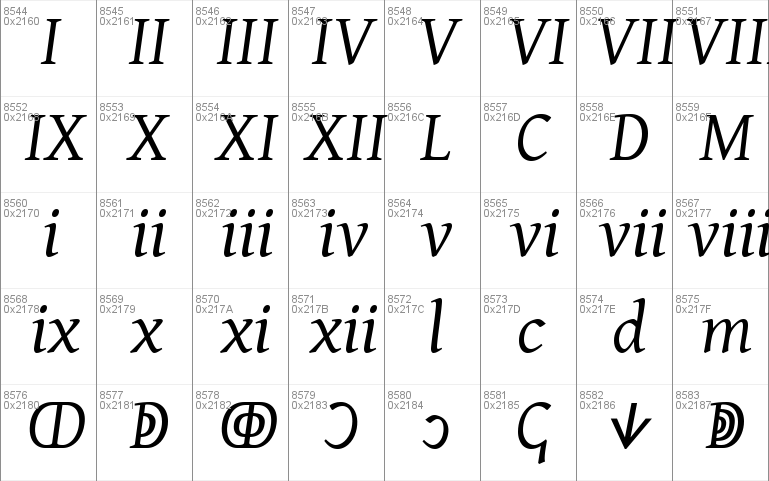
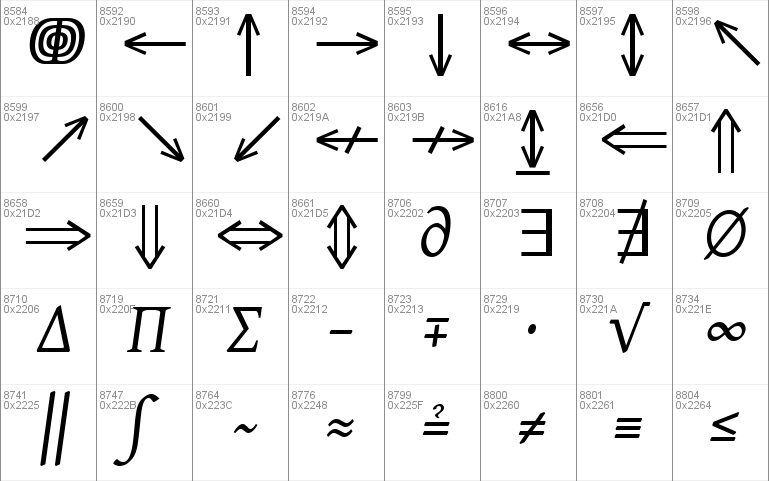
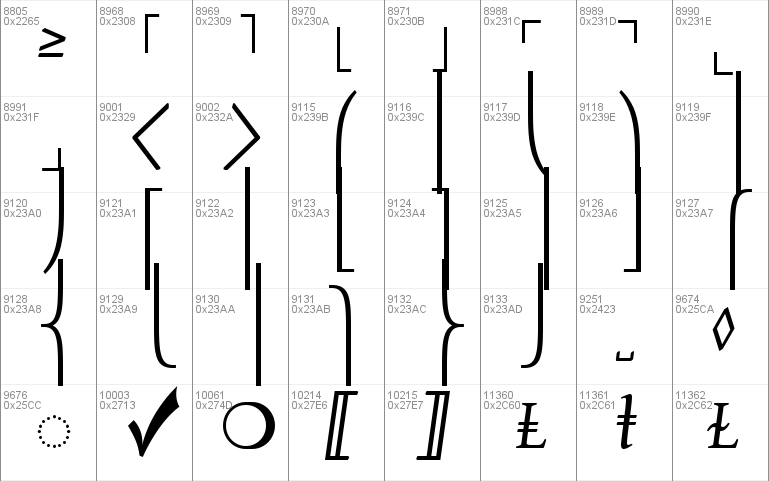
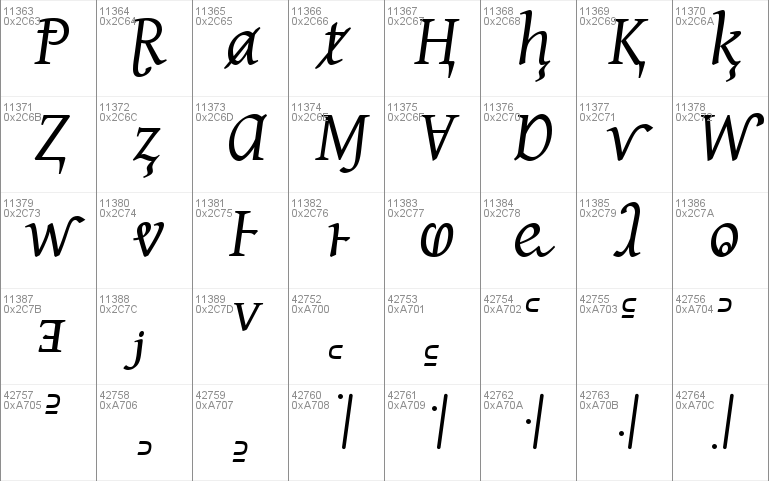
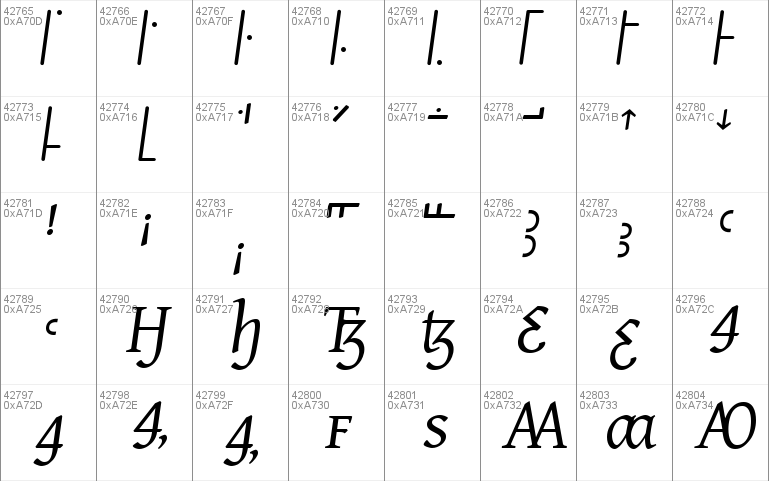
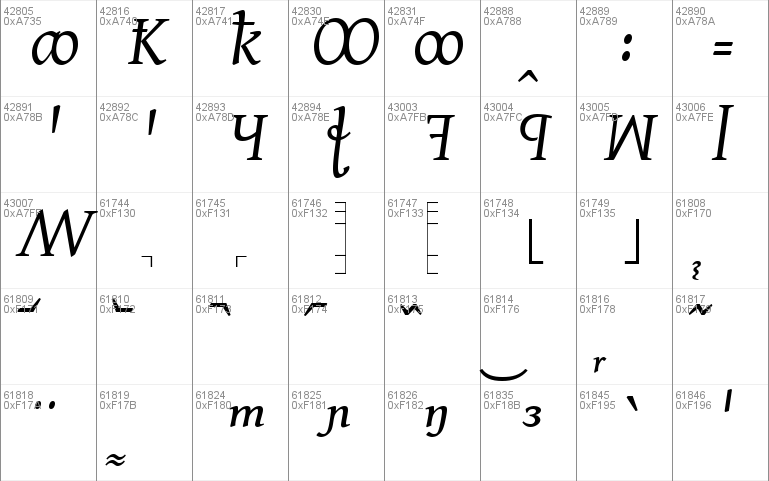
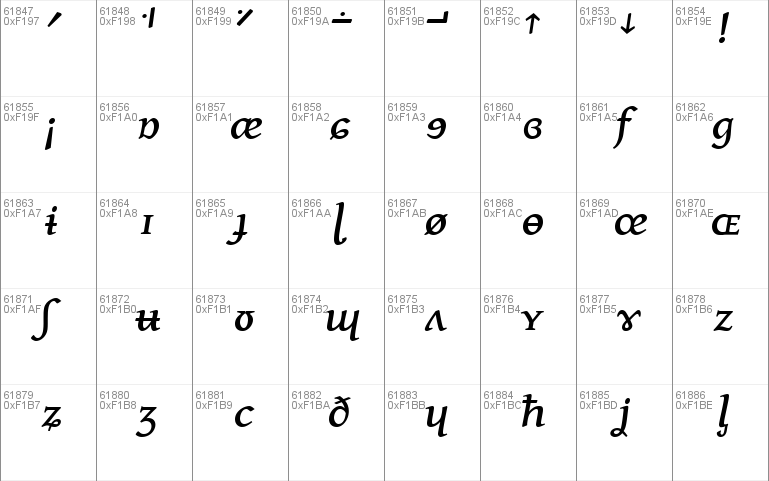
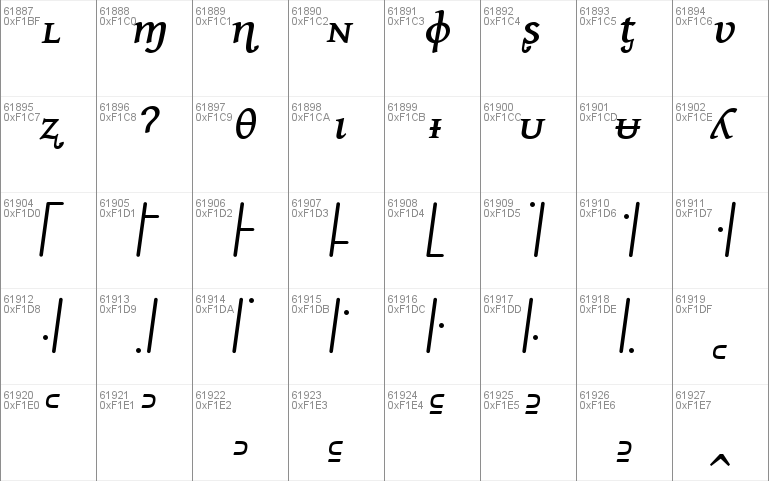
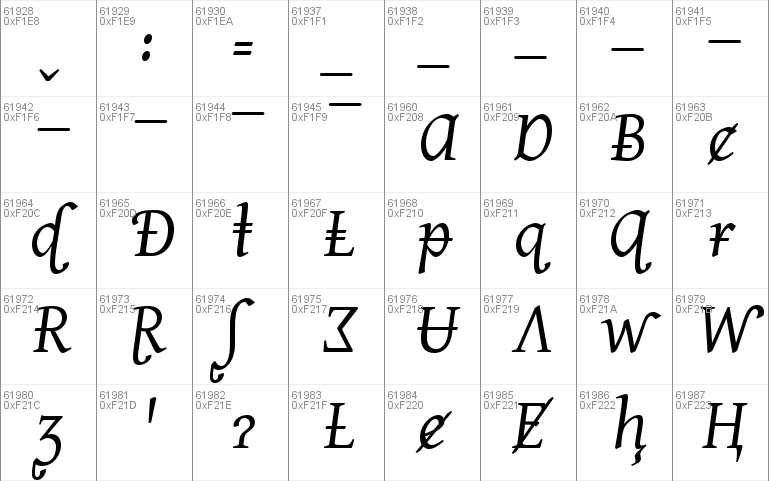
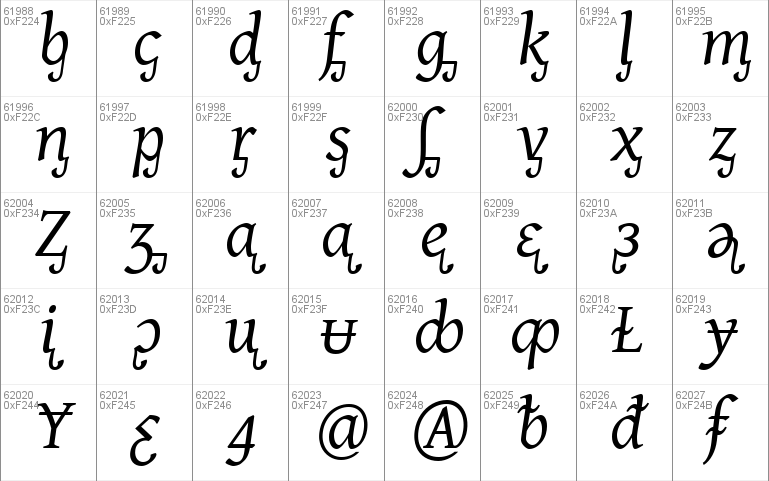
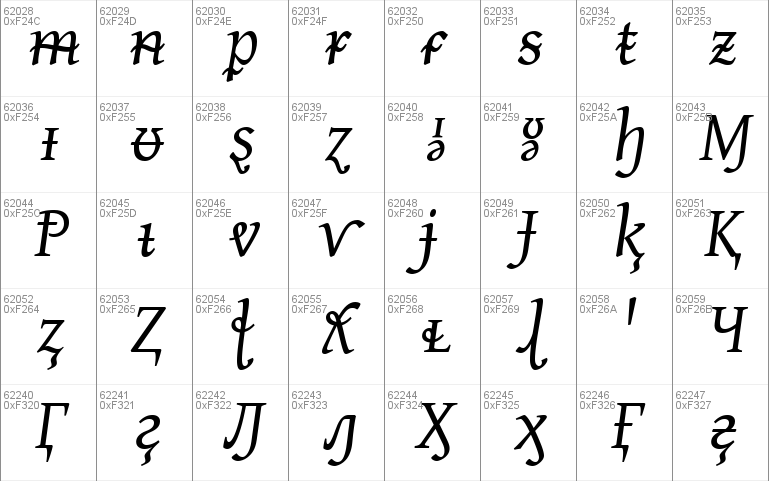
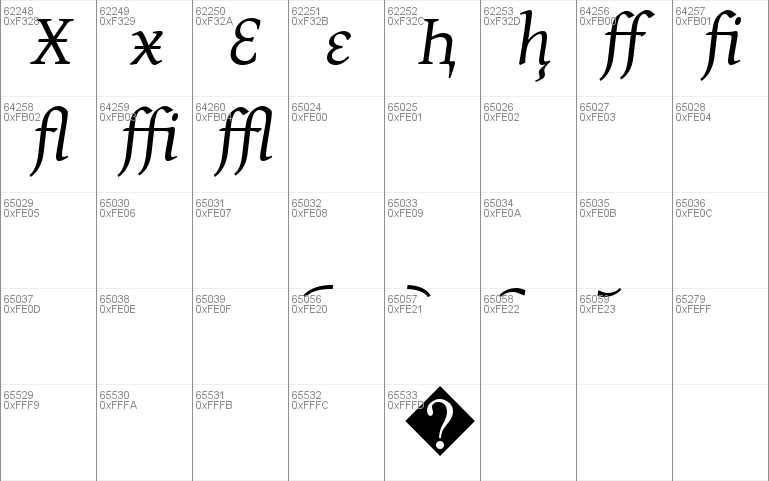
- Styles (2)
- Character Maps
- License































































- Free for Personal Use
- Free for Commercial Use
- Modification Allowed
- Redistribution Allowed
Extended information
Gentium is a typeface family designed to enable the diverse ethnic groups around the world who use the Latin, Cyrillic and Greek scripts to produce readable, high-quality publications. It supports a wide range of Latin- and Cyrillic-based alphabets.
The design is intended to be highly readable, reasonably compact, and visually attractive. The additional ‘extended’ Latin letters are designed to naturally harmonize with the traditional 26 ones. Diacritics are treated with careful thought and attention to their use. Gentium also supports both polytonic and monotonic Greek. Gentium Plus now includes more extended Latin glyphs (Unicode 5.1), archaic Greek symbols, and full extended Cyrillic script support.
Read more
DOCUMENTATION
Gentium Plus v1.504
========================
This file describes the documentation files included with the Gentium Plus font family. This information should be distributed along with the Gentium Plus fonts and any derivative works.
Primary documentation for the Gentium Plus font family is on the Gentium website (http://scripts.sil.org/Gentium).
The GentiumPlus-features.pdf file illustrates the use of OpenType and Graphite features.
The GentiumPlus-features.odt file illustrates the use of OpenType and Graphite features (source file for the pdf).
FONTLOG
Gentium Plus font family
========================
This file provides detailed information on the Gentium Plus family of fonts.
This information should be distributed along with the Gentium Plus fonts and
any derivative works.
Basic Font Information
----------------------
Gentium ("belonging to the nations" in Latin) is a Unicode typeface family
designed to enable the many diverse ethnic groups around the world who use
the Latin script to produce readable, high-quality publications. The
design is intended to be highly readable, reasonably compact, and visually
attractive. Gentium has won a "Certificate of Excellence in Typeface
Design" in two major international typeface design competitions:
bukva:raz! (2001), TDC2003 (2003).
The Gentium Plus font family is based on the original design. It currently
comes with regular and italic face only, although additional weights are in
development.
The goal for this product is to provide a single Unicode-based font family
that contains a comprehensive inventory of glyphs needed for almost any
Roman- or Cyrillic-based writing system, whether used for phonetic or
orthographic needs, and provide a matching Greek face. In addition, there
is provision for other characters and symbols useful to linguists. This
font makes use of state-of-the-art font technologies to support complex
typographic issues, such as the need to position arbitrary combinations
of base glyphs and diacritics optimally.
Two fonts from this typeface family are included in this release:
* Gentium Plus Regular
* Gentium Plus Italic
Work is ongoing to provide bold and bold-italic weights, as well as a
complete book-weight family.
For detailed documentation see the contents of the 'documentation' folder.
A Note Regarding the Open Font License and TypeTuner
----------------------------------------------------
The OFL prohibits the use of Reserved Font Names "Gentium" and "SIL" in
the name of any font that is derived from the Original Version of Gentium
Plus. However, SIL International (the Copyright Holder) grants through
this separate written agreement the right to use the Reserved Font Names
in any Modified Version of this font created by using TypeTuner as long
as the feature information contained in the Original Version is used,
unmodified, as the source for TypeTuner feature information, and
"Gentium Plus" is not the resulting font family name.
TypeTuner-produced fonts created in this manner are still bound by the
terms of the OFL. Specifically, the use of Reserved Font Names is
prohibited when making derivatives of a TypeTuner-produced font. Anyone
making a derivative of a TypeTuner font will need to find a different
name. For example a TypeTuner-produced font may be named
"Gentium Plus Literacy SomeFarAwayPlace" but a derivative of that font made
with other tools would not be allowed to use the "Gentium" and "SIL"
Reserved Font Names and would have to be named something like "Nations Serif".
ChangeLog
---------
(This should list both major and minor changes, most recent first.)
12 September 2011 (SIL NRSI team) Gentium Plus version 1.508
- Removed the VDMX table
- Changed version number (using ttfsetver)
25 Aug 2011 (SIL NRSI team) Gentium Plus version 1.506
- Double-encoded the SIL PUA characters which were added to Unicode 5.2 and 6.0
(using ttfremap)
- Corrected problem with coverage tables (using ttfsortcover)
- Changed version number (using ttfsetver)
- Added device metric tables
- Added an empty dsig table
16 Nov 2010 (SIL NRSI team) Gentium Plus version 1.504
- Added codepage bits for 1251 (Cyrillic), 1257 (Windows Baltic), 1258
(Vietnamese)
1 Nov 2010 (SIL NRSI team) Gentium Plus version 1.502
- Regular and Italic weights only
- New OpenType and Graphite support
- Converted kerning to OpenType (but not Graphite)
- New extended Cyrillic script support, inc. Serbian alternates
- Character set and features up to same level as Charis SIL 4.106
- Support for more historic Greek characters and alternate seriffed beta
- No separate GentiumAlt fonts (replaced by font features)
- Added WOFF versions and examples
28 Nov 2005 (Victor Gaultney) Gentium version 1.02
- Changed licensing to the SIL Open Font License
- Included FontLab source files
- Fixed some duplicate PostScript glyph names
- Fixed italic angle
19 Sep 2003 (Victor Gaultney) Gentium version 1.01
- Maintenance release focused on changing internal font
- Information to reflect the changeover to an SIL project
- There is only one bug fix - the Greek mu PS name was changed to try and fix
a display/printing problem. There is still no manual hinting.
16 Sep 2002 (Victor Gaultney) Gentium version 1.00
- First public release
- No manual hinting is included in this version. Some has been done - with
good results - but is not yet complete enough.
Information for Developers/Contributors
---------------------------------------
The release of Gentium Plus version 1.502 (and any subsequent versions) under
the OFL license provides a means for people to modify the fonts to meet their
needs and contribute to the project. For information on what you're allowed to
change or modify, consult the OFL and OFL-FAQ.
Anyone can make their own modified version of Gentium Plus (using a different
name), but SIL International will continue to maintain and develop the
canonical version of the Gentium Plus fonts. As the package maintainer, we
welcome contributions. Here are some things to keep in mind:
Format: We are open to contributions in various formats, but if you want to
maximise the chances of us including your work, please make it available to
us (via email or a URL) as either a FontLab database (preferred) or a
PostScript Type 1 (or OT-CFF) font.
Source files: The primary source files for the fonts are the fonts themselves.
They contain all the important data in the fonts and can be studied and
modified using open font tools such as FontForge and TTX. The developer
release contains additional source files that might be useful. See the file
source/SOURCES.txt in that release archive for further information.
Copyright attribution: If you submit something for inclusion in the main
Gentium Plus fonts, we will ask you to affirm that it is your original work,
and ask you to assign the copyright of your work to SIL International. This
is to ensure that future releases can be made under improved versions of the
OFL without needing to track you down for further permission. This follows
the same principle used by the FSF. Keep in mind that we are a
not-for-profit organization committed to free/libre and open source
software, and that any contributions incorporated in the fonts will always
be available under the OFL or a similar license.
Quality: Because we want to be able to guarantee a high level of quality for
the primary Gentium Plus fonts, we will review submissions carefully. Please
don't be discouraged if we do not include a submission for this reason, or
ask you to make specific revisions.
Types of contributions: If you wish to make a contribution - a set of
additional glyphs, scripts, code, etc. - please contact us before you do any
work to see if it is a contribution we currently need. Every addition adds
to the complexity of the project and needs to be carefully planned. This
also avoids two people working on the same type of addition at the same time.
Linux packages: Please contact the upstream maintainer of the various
packages - [email protected] - if you want to help package or
maintain a package.
When submissions will be included: We plan to revise the fonts when major
updates are needed (eg new versions of Unicode). If you wish to make
submissions, contact us on the timing.
Acknowledgements
----------------
(Here is where contributors can be acknowledged. If you make modifications be
sure to add your name (N), email (E), web-address (W) and description (D).
This list is sorted by last name in alphabetical order.)
N: Victor Gaultney
E: [email protected]
W: http://www.sil.org/~gaultney/
D: Original Designer
N: Annie Olsen
E: [email protected]
W: http://scripts.sil.org/
D: Contributed some extended Latin glyphs
N: Iska Routamaa
E: [email protected]
W: http://scripts.sil.org/
D: Contributed some extended Latin glyphs and extensive work on the italic face
N: SIL font engineers
E: [email protected]
W: http://scripts.sil.org/
D: Graphite, OpenType, and TypeTuner code, and build support
The Gentium and Gentium Plus fonts are maintained by SIL International.
For more information please visit the Gentium page on SIL International's
Computers and Writing systems website: http://scripts.sil.org/gentium
Or send an email to [email protected]
GENTIUM-FAQ
Gentium Plus v1.508
========================
Here are some answers to frequently asked questions about the Gentium Plus
fonts:
General
========
How do you pronounce Gentium?
The preferred pronunciation is with a soft G as in 'general', not a
hard one as in 'gold': JEN-tee-oom.
Licensing
=========
I want to use Gentium Plus in my publication - can I?
Gentium Plus is released under the SIL Open Font License, which permits
use for any publication, whether electronic or printed. For more answers
to use questions see the OFL-FAQ. The license, alongside information
specific to Gentium Plus, is in the release package.
I would like to bundle Gentium Plus with my application - can I?
This is our most common question. The SIL Open Font License allows
bundling with applications, even commercial closed source ones, with
some restrictions. See the OFL.txt file and the OFL-FAQ.
Can I use the font on my web site?
You can certainly create web pages that request that Gentium Plus be
used to display them (both if that font is already available on the
user's system or if it is delivered via @font-face). According to the
license, you are also allowed to place the font on your site for people
to download it. We would strongly recommend, however, that you direct
users to our site to download the font. This ensures that they are
always using the most recent version with bug fixes, etc. To make this
easier, there is a simple URL for Gentium: http://scripts.sil.org/Gentium
There is further important discussion of webfont issues in the OFL-FAQ.
Is Gentium Plus going to stay unrestricted and available at no cost?
There is no intention to ever charge users for using Gentium and its
variants. The current version is licensed under a free/open license and
future versions will be similarly unencumbered.
Modification
============
I would like to modify Gentium Plus to add a couple of characters I need.
Can I?
Yes - that is allowed as long as you abide by the conditions of the
SIL Open Font License.
So will you add glyphs upon request?
If you have a special symbol that you need (say, for a particular
transcription system), the best means of doing so will be to ensure
that the symbol makes it into the Unicode Standard. It is impossible
for us to add every glyph that every person desires, but we do place
a high priority on adding pretty much anything that falls in certain
Unicode ranges (extended Latin, Greek, Cyrillic). You can send us your
requests, but please understand that we are unlikely to add symbols
where the user base is very small, unless they have been accepted
into Unicode.
Can I send you work I've done to be incorporated into Gentium Plus?
Yes. See the FONTLOG for information on becoming a contributor.
Technical
=========
Can you help me get Gentium Plus working on my system?
We cannot afford to offer individual technical support. The best
resource is this website, where we hope to offer some limited help.
However, we do want to hear of any problems you encounter, so that
we can add them to the list of bugs to fix in later releases.
Our contact address is
that we cannot guarantee a personal response.
I can't find all the extended Latin letters in the font. How do I type them?
Gentium Plus is Unicode-encoded, which means that the computer stores a
special, unique code for each letter in your document. Since most
keyboards do not have hundreds of keys, special software is needed
in order to type the hundreds of special characters supported by the
font. See the README.txt file for more information.
I can't find the 'o with right hook' in the font. Where is it?
Combinations of base letters with diacritics are often called
composite, or pre-composed glyphs. Gentium Plus has hundreds of these
(the ones that are included in Unicode). There are, however, many
common combinations that are not represented by a single composite.
It is possible to enter these into a document, but only as
individual components. So 'o with right hook' would be entered as
'o', then 'right hook'. Although this may not look very good in some
cases, we're not able to anticipate every possible combination.
Gentium Plus includes 'smart font' support for both OpenType and
Graphite.
Some diacritics are not aligning well with base glyphs, and if I type more
than one diacritic, they run into each other. Why is that?
The smart diacritic positioning in Gentium Plus relies on either
OpenType or Graphite. The application you are using must support
one of these technologies in order to see appropriate diacritic
positioning.
How do I type the Greek letters?
You need a Unicode-compatible keyboarding system, which is not
included in the release.
I'm having problems making PDFs -- why won't my document distill?
Gentium Plus is a large font, with lots of glyphs. As a result,
some older printers, PDF distillers and readers can balk at PDFs
that have the complete font embedded. The easiest way to avoid
this is to have the PDF distiller subset the font. This is
generally a good idea anyway (with any font) and can reduce the
size of your files.
Plus
=====
How are the Gentium Plus fonts different from Gentium?
This font is based on the original Gentium design, but with an expanded
character and glyph repertoire. It currently comes with regular and
italic faces. It comes with near-complete support for Latin, Cyrillic
and Greek. It also contains 'smart font' support for OpenType and Graphite
technologies. This allows for correct diacritic placement over all base
characters, whether they are tall, short, wide, narrow, with or without
descenders. It also provides for a large variety of alternates glyphs.
These are described on the Gentium website.
Why is the line spacing greater for the Plus fonts?
In some environments, stacked diacritics in Gentium could display as
'chopped-off'. Gentium Plus has slightly wider default line spacing
in order to avoid this problem. Most applications do, however, let you
set the line spacing explicitly, so you can have the lines spaced
precisely as you wish.
Is there an Alt version of the Basic fonts?
No, although you may notice that capitals and some tall lowercase
letters do use 'low-profile' versions. Gentium Plus also includes
OpenType and Graphite features to turn low-profile diacritics on
and off.
Future
======
What are your future plans for Gentium Plus?
Our next major effort is completing bold and bold italic weights
of Gentium Plus alongside a new Gentium Book Plus family. These new
weights are currently available for Gentium Basic/Gentium Book Basic.
Do you plan to include other typographic enhancements (old style
figures, etc.)?
Those would be nice, wouldn't they? From a design point of view,
it would be great to have these refinements, and we haven't ruled
them out. But there are other needs that are much higher priority
(such as bold). If you think you could contribute some of your time
and effort to these enhancements, see the FONTLOG.txt file for
information on becoming a contributor.
Sans-serif?
There is a definite need for a sans-serif font that shares some of
Gentium's strengths -- high readability, economy of space, etc. It
would also be great if that font also harmonized well with Gentium.
We don't currently have any plans for a companion face, although one
of our other projects - Andika - may be useful. Andika is a sans-serif
font designed specifically for use in literacy programs around the
world, and is available from our web site.
Will you be extending Gentium to cover other scripts, and Hebrew in
particular?
It is very unlikely that we would do this, as there are so many
pressing needs in Latin, Greek and Cyrillic scripts.
Will there be a Type 1 version? What about OpenType?
Gentium Plus includes OpenType and Graphite support. We do not plan
to produce Type 1 versions at this time, but please write us if this
is important (and tell us why). We already provide the PostScript
bézier curves in the 'designsource' files in the developer release.
OFL FAQ - Frequently Asked Questions about the SIL Open Font License (OFL)
Version 1.1-update2 - 23 August 2010
(See http://scripts.sil.org/OFL for updates)
CONTENTS OF THIS FAQ
1 USING AND DISTRIBUTING FONTS LICENSED UNDER THE OFL
2 USING OFL FONTS FOR WEB PAGES AND ONLINE WEBFONT SERVICES
3 MODIFYING OFL-LICENSED FONTS
4 LICENSING YOUR ORIGINAL FONTS UNDER THE OFL
5 CHOOSING RESERVED FONT NAMES
6 ABOUT THE FONTLOG
7 MAKING CONTRIBUTIONS TO OFL PROJECTS
8 ABOUT THE LICENSE ITSELF
9 ABOUT SIL INTERNATIONAL
APPENDIX A - FONTLOG EXAMPLE
1 USING AND DISTRIBUTING FONTS LICENSED UNDER THE OFL
1.1 Can I use the fonts for a book or other print publication?
Yes. You can mention the font and author in the book's colophon if you wish, but that is not required.
1.2 Can the fonts be included with Free/Libre and Open Source Software collections such as GNU/Linux and BSD distributions?
Yes! Fonts licensed under the OFL can be freely included alongside other software under FLOSS (Free/Libre and Open Source Software) licenses. Since fonts are typically aggregated with, not merged into, existing software, there is little need to be concerned about incompatibility with existing software licenses. You may also repackage the fonts and the accompanying components in a .rpm or .deb package and include them in distribution CD/DVDs and online repositories. (Also see section 5.9 about rebuilding from source.)
1.3 I want to distribute the fonts with my program. Does this mean my program also has to be Free/Libre and Open Source Software?
No. Only the portions based on the Font Software are required to be released under the OFL. The intent of the license is to allow aggregation or bundling with software under restricted licensing as well.
1.4 Can I sell a software package that includes these fonts?
Yes, you can do this with both the Original Version and a Modified Version of the fonts. Examples of bundling made possible by the OFL would include: word processors, design and publishing applications, training and educational software, games and entertainment software, mobile device applications, etc.
1.5 Can I include the fonts on a CD of freeware or commercial fonts?
Yes, as long some other font or software is also on the disk, so the OFL font is not sold by itself.
1.6 Why won't the OFL let me sell the fonts alone?
The intent is to keep people from making money by simply redistributing the fonts. The only people who ought to profit directly from the fonts should be the original authors, and those authors have kindly given up potential direct income to distribute their fonts under the OFL. Please honour and respect their contribution!
1.7 What about sharing OFL fonts with friends on a CD, DVD or USB stick?
You are very welcome to share open fonts with friends, family and colleagues through removable media. Just remember to include the full font package, including any copyright notices and licensing information as available in OFL.txt. In the case where you sell the font, it has to come bundled with software.
1.8 Can I host the fonts on a web site for others to use?
Yes, as long as you make the full font package available. In most cases it may be best to point users to the main site that distributes the Original Version so they always get the most recent stable and complete version. See also discussion of webfonts in Section 2.
1.9 Can I host the fonts on a server for use over our internal network?
Yes. If the fonts are transferred from the server to the client computer by means that allow them to be used even if the computer is no longer attached to the network, the full package (copyright notices, licensing information, etc.) should be included.
1.10 Does the full OFL license text always need to accompany the font?
The only situation in which an OFL font can be distributed without the text of the OFL (either in a separate file or in font metadata), is when a font is embedded in a document or bundled within a program. In the case of metadata included within a font, it is legally sufficient to include only a link to the text of the OFL on http://scripts.sil.org/OFL, but we strongly recommend against this. Most modern font formats include metadata fields that will accept the full OFL text, and full inclusion increases the likelihood that users will understand and properly apply the license.
1.11 What do you mean by 'embedding'? How does that differ from other means of distribution?
By 'embedding' we mean inclusion of the font in a document or file in a way that makes extraction (and redistribution) difficult or clearly discouraged. In many cases the names of embedded fonts might also not be obvious to those reading the document, the font data format might be altered, and only a subset of the font - only the glyphs required for the text - might be included. Any other means of delivering a font to another person is considered 'distribution', and needs to be accompanied by any copyright notices and licensing information available in OFL.txt.
1.12 So can I embed OFL fonts in my document?
Yes, either in full or a subset. The restrictions regarding font modification and redistribution do not apply, as the font is not intended for use outside the document.
1.13 Does embedding alter the license of the document itself?
No. Referencing or embedding an OFL font in any document does not change the license of the document itself. The requirement for fonts to remain under the OFL does not apply to any document created using the fonts and their derivatives. Similarly, creating any kind of graphic using a font under OFL does not make the resulting artwork subject to the OFL.
1.14 If OFL fonts are extracted from a document in which they are embedded (such as a PDF file), what can be done with them? Is this a risk to author(s)?
The few utilities that can extract fonts embedded in a PDF will typically output limited amounts of outlines - not a complete font. To create a working font from this method is much more difficult and time consuming than finding the source of the original OFL font. So there is little chance that an OFL font would be extracted and redistributed inappropriately through this method. Even so, copyright laws address any misrepresentation of authorship. All Font Software released under the OFL and marked as such by the author(s) is intended to remain under this license regardless of the distribution method, and cannot be redistributed under any other license. We strongly discourage any font extraction - we recommend directly using the font sources instead - but if you extract font outlines from a document, please be considerate: use your common sense and respect the work of the author(s) and the licensing model.
1.15 What about distributing fonts with a document? Within a compressed folder structure? Is it distribution, bundling or embedding?
Certain document formats may allow the inclusion of an unmodified font within their file structure which consists of a compressed folder containing the various resources forming the document (such as pictures and thumbnails). Including fonts within such a structure is understood as being different from embedding but rather similar to bundling (or mere aggregation) which the license explicitly allows. In this case the font is conveyed unchanged whereas embedding a font usually transforms it from the original format. The OFL does not allow anyone to extract the font from such a structure to then redistribute it under another license. The explicit permission to redistribute and embed does not cancel the requirement for the Font Software to remain under the license chosen by its author(s).
1.16 What about ebooks shipping with open fonts?
The requirements differ depending on whether the fonts are linked, embedded or distributed (bundled or aggregated). Some ebook formats use web technologies to do font linking via @font-face, others are designed for font embedding, some use fonts distributed with the document or reading software, and a few rely solely on the fonts already present on the target system. The license requirements depend on the type of inclusion as discussed in 1.15.
1.17 Can Font Software released under the OFL be subject to URL-based access restrictions methods or DRM (Digital Rights Management) mechanisms?
Yes, but these issues are out-of-scope for the OFL. The license itself neither encourages their use nor prohibits them since such mechanisms are not implemented in the components of the Font Software but through external software. Such restrictions are put in place for many different purposes corresponding to various usage scenarios. One common example is to limit potentially dangerous cross-site scripting attacks. However, in the spirit of libre/open fonts and unrestricted writing systems, we strongly encourage open sharing and reuse of OFL fonts, and the establishment of an environment where such restrictions are unnecessary. Note that whether you wish to use such mechanisms or you prefer not to, you must still abide by the rules set forth by the OFL when using fonts released by their authors under this license. Derivative fonts must be licensed under the OFL, even if they are part of a service for which you charge fees and/or for which access to source code is restricted. You may not sell the fonts on their own - they must be part of a larger software package, bundle or subscription plan. For example, even if the OFL font is distributed in a software package or via an online service using a DRM mechanism, the user would still have the right to extract that font, use, study, modify and redistribute it under the OFL.
1.18 I've come across a font released under the OFL. How can I easily get more information about the Original Version? How can I know where it stands compared to the Original Version or other Modified Versions?
Consult the copyright statement(s) in the license for ways to contact the original authors. Consult the FONTLOG for information on how the font differs from the Original Version, and get in touch with the various contributors via the information in the acknowledgement section. Please consider using the Original Versions of the fonts whenever possible.
1.19 What do you mean in condition 4? Can you provide examples of abusive promotion / endorsement / advertisement vs. normal acknowledgement?
The intent is that the goodwill and reputation of the author(s) should not be used in a way that makes it sound like the original author(s) endorse or approve of a specific Modified Version or software bundle. For example, it would not be right to advertise a word processor by naming the author(s) in a listing of software features, or to promote a Modified Version on a web site by saying "designed by ...". However, it would be appropriate to acknowledge the author(s) if your software package has a list of people who deserve thanks. We realize that this can seem to be a grey area, but the standard used to judge an acknowledgement is that if the acknowledgement benefits the author(s) it is allowed, but if it primarily benefits other parties, or could reflect poorly on the author(s), then it is not.
2 USING OFL FONTS FOR WEBPAGES AND ONLINE WEBFONT SERVICES
2.1 Can I make webpages using these fonts?
Yes! Go ahead! Using CSS (Cascading Style Sheets) is recommended. Your three best options:
- referring directly in your stylesheet to open fonts which may be available on the user's system
- providing links to download the full package of the font - either from your own website or from elsewhere - so users can install it themselves
- using @font-face to distribute the font directly to browsers. This is recommended and explicitly allowed by the licensing model because it is distribution. The font file itself is distributed with other components of the webpage. It is not embedded in the webpage but referenced through a web address which will cause the browser to retrieve and use the corresponding font to render the webpage (see 1.11 and 1.15 for details related to embedding fonts into documents). As you take advantage of the @font-face cross-platform standard, be aware that webfonts are often tuned for a web environment and not intended for installation and use outside a browser. The reasons in favour of using webfonts are to allow design of dynamic text elements instead of static graphics, to make it easier for content to be localized and translated, indexed and searched, and all this with cross-platform open standards without depending on restricted extensions or plugins. You should check the CSS cascade (the order in which fonts are being called or delivered to your users) when testing.
2.2 Can I make and use WOFF (Web Open Font Format) versions of OFL fonts?
Yes, but you need to be careful. A change in font format normally is considered modification, and Reserved Font Names (RFNs) cannot be used. Because of the design of the WOFF format, however, it is possible to create a WOFF version that is not considered modification, and so would not require a name change. You are allowed to create, use and distribute a WOFF version of an OFL font without changing the font name, but only if:
- the original font data remains unchanged except for WOFF compression, and
- WOFF-specific metadata is either omitted altogether or present and includes, unaltered, the contents of all equivalent metadata in the original font.
If the original font data or metadata is changed, or the WOFF-specific metadata is incomplete, the font must be considered a Modified Version, the OFL restrictions would apply and the name of the font must be changed: any RFNs cannot be used and copyright notices and licensing information must be included and cannot be deleted or modified. You must come up with a unique name - we recommend one corresponding to your domain or your particular web application. Be aware that only the original author(s) can use RFNs. This is to prevent collisions between a derivative tuned to your audience and the original upstream version and so to reduce confusion.
Please note that most WOFF conversion tools and online services do not meet the two requirements listed above, and so their output must be considered a Modified Version. So be very careful and check to be sure that the tool or service you're using is compressing unchanged data and completely and accurately reflecting the original font metadata.
2.3 What about other webfont formats such as EOT/EOTLite/CWT/etc.?
In most cases these formats alter the original font data more than WOFF, and do not completely support appropriate metadata, so their use must be considered modification and RFNs may not be used.
2.4 Can I make OFL fonts available through webfont online services?
Yes, you are welcome to include OFL fonts in online webfont services as long as you properly meet all the conditions of the license. The origin and open status of the font should be clear among the other fonts you are hosting. Authorship, copyright notices and license information must be sufficiently visible to your users or subscribers so they know where the font comes from and the rights granted by the author(s). Make sure the font file contains the needed copyright notice(s) and licensing information in its metadata. Please double-check the accuracy of every field to prevent contradictory information. Other font formats, including EOT/EOTLite/CWT and superior alternatives like WOFF, already provide fields for this information. Remember that if you modify the font within your library or convert it to another format for any reason the OFL restrictions apply and you need to change the names accordingly. Please respect the author's wishes as expressed in the OFL and do not misrepresent original designers and their work. Don't lump quality open fonts together with dubious freeware or public domain fonts. Consider how you can best work with the original designers and foundries, support their efforts and generate goodwill that will benefit your service. (See 1.17 for details related to URL-based access restrictions methods or DRM mechanisms).
2.5 Can I make and publish CMS themes or templates that use OFL fonts? Can I include the fonts themselves in the themes or templates? Can I sell the whole package?
Yes, you are very welcome to integrate open fonts into themes and templates for your preferred CMS and make them more widely available. Be aware that you can only sell the fonts and your CMS add-on as part of a software bundle. (See 1.4 for details and examples about selling bundles).
2.6 Some webfont formats and services provide ways of "optimising" the font for a particular website or web application; is that allowed?
Yes, it is permitted, but remember that these optimised versions are Modified Versions and so must follow OFL requirements like appropriate renaming. Also you need to bear in mind the other important parameters beyond compression, speed and responsiveness: you need to consider the audience of your particular website or web application, as choosing some optimisation parameters may turn out to be less than ideal for them. Subsetting by removing certain glyphs or features may seriously limit functionality of the font in various languages used by your users. It may also introduce degradation of quality in the rendering or specific bugs on the various platforms compared to the original font. In other words, remember that one person's optimised font may be another person's missing feature. Various advanced typographic features are also available through CSS and may provide the desired effects without the need to modify the font.
3 MODIFYING OFL-LICENSED FONTS
3.1 Can I change the fonts? Are there any limitations to what things I can and cannot change?
You are allowed to change anything, as long as such changes do not violate the terms of the license. In other words, you are not allowed to remove the copyright statement(s) from the font, but you could put additional information into it that covers your contribution.
3.2 I have a font that needs a few extra glyphs - can I take them from an OFL licensed font and copy them into mine?
Yes, but if you distribute that font to others it must be under the OFL, and include the information mentioned in condition 2 of the license.
3.3 Can I charge people for my additional work? In other words, if I add a bunch of special glyphs and/or OpenType/Graphite code, can I sell the enhanced font?
Not by itself. Derivative fonts must be released under the OFL and cannot be sold by themselves. It is permitted, however, to include them in a larger software package (such as text editors, office suites or operating systems), even if the larger package is sold. In that case, you are strongly encouraged, but not required, to also make that derived font easily and freely available outside of the larger package.
3.4 Can I pay someone to enhance the fonts for my use and distribution?
Yes. This is a good way to fund the further development of the fonts. Keep in mind, however, that if the font is distributed to others it must be under the OFL. You won't be able to recover your investment by exclusively selling the font, but you will be making a valuable contribution to the community. Please remember how you have benefited from the contributions of others.
3.5 I need to make substantial revisions to the font to make it work with my program. It will be a lot of work, and a big investment, and I want to be sure that it can only be distributed with my program. Can I restrict its use?
No. If you redistribute a Modified Version of the font it must be under the OFL. You may not restrict it in any way beyond what the OFL permits and requires. This is intended to ensure that all released improvements to the fonts become available to everyone. But you will likely get an edge over competitors by being the first to distribute a bundle with the enhancements. Again, please remember how you have benefited from the contributions of others.
3.6 Do I have to make any derivative fonts (including extended source files, build scripts, documentation, etc.) publicly available?
No, but please consider sharing your improvements with others. You may find that you receive in return more than what you gave.
3.7 If a trademark is claimed in the OFL font, does that trademark need to remain in modified fonts?
Yes, any trademark notices must remain in any derivative fonts to respect trademark laws, but you may add any additional trademarks you claim, officially registered or not. For example if an OFL font called "Foo" contains a notice that "Foo is a trademark of Acme", then if you rename the font to "Bar" when creating a Modified Version, the new trademark notice could say "Foo is a trademark of Acme Inc. - Bar is a trademark of Roadrunner Technologies Ltd.". Trademarks work alongside the OFL and are not subject to the terms of the licensing agreement. Please refer to the appropriate trademark laws.
4 LICENSING YOUR ORIGINAL FONTS UNDER THE OFL
4.1 Can I use the SIL OFL for my own fonts?
Yes! We heartily encourage everyone to use the OFL to distribute their own original fonts. It is a carefully constructed license that allows great freedom along with enough artistic integrity protection for the work of the authors as well as clear rules for other contributors and those who redistribute the fonts. The licensing model is used successfully by various organisations, both for-profit and not-for-profit, to release fonts of varying levels of scope and complexity.
4.2 What do I have to do to apply the OFL to my font?
If you want to release your fonts under the OFL, we recommend you do the following:
4.2.1 Put your copyright and Reserved Font Names information at the beginning of the main OFL.txt file in place of the dedicated placeholders. Include this file in your release package.
4.2.2 Put your copyright and the OFL text with Reserved Font Names into your font files (the copyright and license fields). A link to the OFL text on the OFL web site is an acceptable (but not recommended) alternative. Also add this information to any other components (build scripts, glyph databases, documentation, test files, etc). Depending on the format of your fonts and sources, you can use template human-readable headers or machine-readable metadata.
4.2.3 Write an initial FONTLOG.txt for your font and include it in the release package.
4.2.4 Include the relevant practical documentation on the license by including the OFL-FAQ.txt in your package.
4.3 Will you make my font OFL for me?
We won't do the work for you. We can, however, try to answer your questions, unfortunately we do not have the resources to review and check your font packages for correct use of the OFL.
4.4 Will you distribute my OFL font for me?
No, although if the font is of sufficient quality and general interest we may include a link to it on our partial list of OFL fonts on the OFL web site. You may wish to consider other open font catalogs or hosting services, such as the Unifont Font Guide (http://unifont.org/fontguide), The League of Movable Type (http://theleagueofmovabletype.com), Kernest (http://kernest.com/) or the Open Font Library (http://openfontlibrary.org/), which despite the name has no direct relationship to the OFL or SIL. We do not endorse any particular catalog or hosting service - it is your responsibility to determine if the service is right for you.
4.5 Why should I use the OFL for my fonts?
- to meet needs for fonts that can be modified to support minority languages
- to provide a legal and clear way for people to respect your work but still use it (and reduce piracy)
- to involve others in your font project
- to enable your fonts to be expanded with new weights and improved writing system/language support
- to allow more technical font developers to add features to your design (such as OpenType and Graphite support)
- to renew the life of an old font lying on your hard drive with no business model
- to allow your font to be included in Libre Software operating systems like Ubuntu
- to give your font world status and wide, unrestricted distribution
- to educate students about quality typeface and font design
- to expand your test base and get more useful feedback
- to extend your reach to new markets when users see your metadata and go to your website
- to get your font more easily into one of the webfont online services
- to attract attention for your commercial fonts
- to make money through webfont services
- to make money by bundling fonts with applications
- to make money adjusting and extending existing open fonts
- to get a better chance that foundations/NGOs/charities/companies who commission fonts will pick you
- to be part of a sharing design and development community
- to give back and contribute to a growing body of font sources
5 CHOOSING RESERVED FONT NAMES
5.1 What are Reserved Font Names?
These are font names, or portions of font names, that the author has chosen to reserve for use only with the Original Version of the font, or for Modified Version(s) created by the original author.
5.2 Why can't I use the Reserved Font Names in my derivative font names? I'd like people to know where the design came from.
The best way to acknowledge the source of the design is to thank the original authors and any other contributors in the files that are distributed with your revised font (although no acknowledgement is required). The FONTLOG is a natural place to do this. Reserved Font Names ensure that the only fonts that have the original names are the unmodified Original Versions. This allows designers to maintain artistic integrity while allowing collaboration to happen. It eliminates potential confusion and name conflicts. When choosing a name, be creative and avoid names that reuse almost all the same letters in the same order or sound like the original. It will help everyone if Original Versions and Modified Versions can easily be distinguished from one another and from other derivatives. Any substitution and matching mechanism is outside the scope of the license.
5.3 What do you mean by "primary name as presented to the user"? Are you referring to the font menu name?
Yes, this applies to the font menu name and other mechanisms that specify a font in a document. It would be fine, however, to keep a text reference to the original fonts in the description field, in your modified source file or in documentation provided alongside your derivative as long as no one could be confused that your modified source is the original. But you cannot use the Reserved Font Names in any way to identify the font to the user (unless the Copyright Holder(s) allow(s) it through a separate agreement). Users who install derivatives (Modified Versions) on their systems should not see any of the original Reserved Font Names in their font menus, for example. Again, this is to ensure that users are not confused and do not mistake one font for another and so expect features only another derivative or the Original Version can actually offer.
5.4 Am I not allowed to use any part of the Reserved Font Names?
You may not use individual words from the Reserved Font Names, but you would be allowed to use parts of words, as long as you do not use any word from the Reserved Font Names entirely. We do not recommend using parts of words because of potential confusion, but it is allowed. For example, if "Foobar" was a Reserved Font Name, you would be allowed to use "Foo" or "bar", although we would not recommend it. Such an unfortunate choice would confuse the users of your fonts as well as make it harder for other designers to contribute.
5.5 So what should I, as an author, identify as Reserved Font Names?
Original authors are encouraged to name their fonts using clear, distinct names, and only declare the unique parts of the name as Reserved Font Names. For example, the author of a font called "Foobar Sans" would declare "Foobar" as a Reserved Font Name, but not "Sans", as that is a common typographical term, and may be a useful word to use in a derivative font name. Reserved Font Names should also be single words. A font called "Flowing River" should have Reserved Font Names "Flowing" and "River", not "Flowing River". You also need to be very careful about reserving font names which are already linked to trademarks (whether registered or not) which you do not own.
5.6 Do I, as an author, have to identify any Reserved Font Names?
No, but we strongly encourage you to do so. This is to avoid confusion between your work and Modified Versions.
5.7 Are any names (such as the main font name) reserved by default?
No. That is a change to the license as of version 1.1. If you want any names to be Reserved Font Names, they must be specified after the copyright statement(s).
5.8 Is there any situation in which I can use Reserved Font Names for a Modified Version?
The Copyright Holder(s) can give certain trusted parties the right to use any of the Reserved Font Names through separate written agreements. For example, even if "Foobar" is a RFN, you could write up an agreement to give company "XYZ" the right to distribute a modified version with a name that includes "Foobar". This allows for freedom without confusion.
5.9 Do font rebuilds require a name change? Do I have to change the name of the font when my packaging workflow includes a full rebuild from source?
Yes, all rebuilds which change the font data and the smart code are Modified Versions and the requirements of the OFL apply: you need to respect what the Author(s) have chosen in terms of Reserved Font Names. However if a package (or installer) is simply a wrapper or a compressed structure around the final font - leaving them intact on the inside - then no name change is required. Please get in touch with the author(s) and copyright holder(s) to inquire about the presence of font sources beyond the final font file(s) and the recommended build path. That build path may very well be non-trivial and hard to reproduce accurately by the maintainer. If a full font build path is made available by the upstream author(s) please be aware that any regressions and changes you may introduce when doing a rebuild for packaging purposes is your responsibility as a package maintainer since you are effectively creating a separate branch. You should make it very clear to your users that your rebuilt version is not the canonical one from upstream.
5.10 Can I add other Reserved Font Names when making a derivative font?
Yes. List your additional Reserved Font Names after your additional copyright statement, as indicated with example placeholders at the top of the OFL.txt file. Be sure you do not remove any exiting RFNs but only add your own.
6 ABOUT THE FONTLOG
6.1 What is this FONTLOG thing exactly?
It has three purposes: 1) to provide basic information on the font to users and other developers, 2) to document changes that have been made to the font or accompanying files, either by the original authors or others, and 3) to provide a place to acknowledge authors and other contributors. Please use it!
6.2 Is the FONTLOG required?
It is not a requirement of the license, but we strongly recommend you have one.
6.3 Am I required to update the FONTLOG when making Modified Versions?
No, but users, designers and other developers might get very frustrated with you if you don't. People need to know how derivative fonts differ from the original, and how to take advantage of the changes, or build on them. There are utilities that can help create and maintain a FONTLOG, such as the FONTLOG support in FontForge.
6.4 What should the FONTLOG look like?
It is typically a separate text file (FONTLOG.txt), but can take other formats. It commonly includes these four sections:
- brief header describing the FONTLOG itself and name of the font family
- Basic Font Information - description of the font family, purpose and breadth
- ChangeLog - chronological listing of changes
- Acknowledgements - list of authors and contributors with contact information
It could also include other sections, such as: where to find documentation, how to make contributions, information on contributing organizations, source code details, and a short design guide. See Appendix A for an example FONTLOG.
7 MAKING CONTRIBUTIONS TO OFL PROJECTS
7.1 Can I contribute work to OFL projects?
In many cases, yes. It is common for OFL fonts to be developed by a team of people who welcome contributions from the wider community. Contact the original authors for specific information on how to participate in their projects.
7.2 Why should I contribute my changes back to the original authors?
It would benefit many people if you contributed back in response to what you've received. Your contributions and improvements to the fonts and other components could be a tremendous help and would encourage others to contribute as well and 'give back'. You will then benefit from other people's contributions as well. Sometimes maintaining your own separate version takes more effort than merging back with the original. Be aware that any contributions, however, must be either your own original creation or work that you own, and you may be asked to affirm that clearly when you contribute.
7.3 I've made some very nice improvements to the font. Will you consider adopting them and putting them into future Original Versions?
Most authors would be very happy to receive such contributions. Keep in mind that it is unlikely that they would want to incorporate major changes that would require additional work on their end. Any contributions would likely need to be made for all the fonts in a family and match the overall design and style. Authors are encouraged to include a guide to the design with the fonts. It would also help to have contributions submitted as patches or clearly marked changes - the use of smart source revision control systems like subversion, svk, mercurial, git or bzr is a good idea. Please follow the recommendations given by the author(s) in terms of preferred source formats and configuration parameters for sending contributions. If this is not indicated in a FONTLOG or other documentation of the font, consider asking them directly. Examples of useful contributions are bug fixes, additional glyphs, stylistic alternates (and the smart font code to access them) or improved hinting. Keep in mind that some kinds of changes (esp. hinting) may be technically difficult to integrate.
7.4 How can I financially support the development of OFL fonts?
It is likely that most authors of OFL fonts would accept financial contributions - contact them for instructions on how to do this. Such contributions would support future development. You can also pay for others to enhance the fonts and contribute the results back to the original authors for inclusion in the Original Version.
8 ABOUT THE LICENSE ITSELF
8.1 I see that this is version 1.1 of the license. Will there be later changes?
Version 1.1 is the first minor revision of the OFL. We are confident that version 1.1 will meet most needs, but are open to future improvements. Any revisions would be for future font releases, and previously existing licenses would remain in effect. No retroactive changes are possible, although the Copyright Holder(s) can re-release the font under a revised OFL. All versions will be available on our web site: http://scripts.sil.org/OFL.
8.2 Does this license restrict the rights of the Copyright Holder(s)?
No. The Copyright Holder(s) still retain(s) all the rights to their creation; they are only releasing a portion of it for use in a specific way. For example, the Copyright Holder(s) may choose to release a 'basic' version of their font under the OFL, but sell a restricted 'enhanced' version. Only the Copyright Holder(s) can do this.
8.3 Is the OFL a contract or a license?
The OFL is a license and not a contract and so does not require you to sign it to have legal validity. By using, modifying and redistributing components under the OFL you indicate that you accept the license.
8.4 I really like the terms of the OFL, but want to change it a little. Am I allowed to take ideas and actual wording from the OFL and put them into my own custom license for distributing my fonts?
We strongly recommend against creating your very own unique open licensing model. Using a modified or derivative license will likely cut you off - along with the font(s) under that license - from the community of designers using the OFL, potentially expose you and your users to legal liabilities, and possibly put your work and rights at risk. The OFL went though a community and legal review process that took years of effort, and that review is only applicable to an unmodified OFL. The text of the OFL has been written by SIL (with review and consultation from the community) and is copyright (c) 2005-2010 SIL International. You may re-use the ideas and wording (in part, not in whole) in another non-proprietary license provided that you call your license by another unambiguous name, that you do not use the preamble, that you do not mention SIL and that you clearly present your license as different from the OFL so as not to cause confusion by being too similar to the original. If you feel the OFL does not meet your needs for an open license, please contact us.
8.5 Can I translate the license and the FAQ into other languages?
SIL certainly recognises the need for people who are not familiar with English to be able to understand the OFL and its use. Making the license very clear and readable has been a key goal for the OFL, but we know that people understand their own language best.
If you are an experienced translator, you are very welcome to translate the OFL and OFL-FAQ so that designers and users in your language community can understand the license better. But only the original English version of the license has legal value and has been approved by the community. Translations do not count as legal substitutes and should only serve as a way to explain the original license. SIL - as the author and steward of the license for the community at large - does not approve any translation of the OFL as legally valid because even small translation ambiguities could be abused and create problems.
SIL gives permission to publish unofficial translations into other languages provided that they comply with the following guidelines:
- Put the following disclaimer in both English and the target language stating clearly that the translation is unofficial:
"This is an unofficial translation of the SIL Open Font License into
- Keep your unofficial translation current and update it at our request if needed, for example if there is any ambiguity which could lead to confusion.
If you start such a unofficial translation effort of the OFL and OFL-FAQ please let us know.
9 ABOUT SIL INTERNATIONAL
9.1 Who is SIL International and what do they do?
SIL serves language communities worldwide, building their capacity for sustainable language development, by means of research, translation, training and materials development. SIL makes its services available to all without regard to religious belief, political ideology, gender, race, or ethnic background. SIL's members and volunteers share a Christian commitment.
9.2 What does this have to do with font licensing?
The ability to read, write, type and publish in one's own language is one of the most critical needs for millions of people around the world. This requires fonts that are widely available and support lesser-known languages. SIL develops - and encourages others to develop - a complete stack of writing systems implementation components available under open licenses. This open stack includes input methods, smart fonts, smart rendering libraries and smart applications. There has been a need for a common open license that is specifically applicable to fonts and related software (a crucial component of this stack), so SIL developed the SIL Open Font License with the help of the Free/Libre and Open Source Software community.
9.3 How can I contact SIL?
Our main web site is: http://www.sil.org/
Our site about complex scripts is: http://scripts.sil.org/
Information about this license (and contact information) is at: http://scripts.sil.org/OFL
APPENDIX A - FONTLOG EXAMPLE
Here is an example of the recommended format for a FONTLOG, although other formats are allowed.
-----
FONTLOG for the GlobalFontFamily fonts
This file provides detailed information on the GlobalFontFamily Font Software. This information should be distributed along with the GlobalFontFamily fonts and any derivative works.
Basic Font Information
GlobalFontFamily is a Unicode typeface family that supports all languages that use the Latin script and its variants, and could be expanded to support other scripts.
NewWorldFontFamily is based on the GlobalFontFamily and also supports Greek, Hebrew, Cyrillic and Armenian.
More specifically, this release supports the following Unicode ranges...
This release contains...
Documentation can be found at...
To contribute to the project...
ChangeLog
1 August 2008 (Tom Parker) GlobalFontFamily version 1.2.1
- Tweaked the smart font code (Branch merged with trunk version)
- Provided improved build and debugging environment for smart behaviours
7 February 2007 (Pat Johnson) NewWorldFontFamily Version 1.3
- Added Greek and Cyrillic glyphs
7 March 2006 (Fred Foobar) NewWorldFontFamily Version 1.2
- Tweaked contextual behaviours
1 Feb 2005 (Jane Doe) NewWorldFontFamily Version 1.1
- Improved build script performance and verbosity
- Extended the smart code documentation
- Corrected minor typos in the documentation
- Fixed position of combining inverted breve below (U+032F)
- Added OpenType/Graphite smart code for Armenian
- Added Armenian glyphs (U+0531 -> U+0587)
- Released as "NewWorldFontFamily"
1 Jan 2005 (Joe Smith) GlobalFontFamily Version 1.0
- Initial release
Acknowledgements
If you make modifications be sure to add your name (N), email (E), web-address (if you have one) (W) and description (D). This list is in alphabetical order.
N: Jane Doe
E: [email protected]
W: http://art.university.edu/projects/fonts
D: Contributor - Armenian glyphs and code
N: Fred Foobar
E: [email protected]
W: http://foobar.org
D: Contributor - misc Graphite fixes
N: Pat Johnson
E: [email protected]
W: http://pat.fontstudio.org
D: Designer - Greek & Cyrillic glyphs based on Roman design
N: Tom Parker
E: [email protected]
W: http://www.company.com/tom/projects/fonts
D: Engineer - original smart font code
N: Joe Smith
E: [email protected]
W: http://joe.fontstudio.org
D: Designer - original Roman glyphs
Fontstudio.org is an not-for-profit design group whose purpose is...
Foobar.org is a distributed community of developers...
Company.com is a small business who likes to support community designers...
University.edu is a renowed educational institution with a strong design department...
-----
Copyright (c) 2003-2011 SIL International (http://www.sil.org/),
with Reserved Font Names "Gentium" and "SIL".
This Font Software is licensed under the SIL Open Font License, Version 1.1.
This license is copied below, and is also available with a FAQ at:
http://scripts.sil.org/OFL
-----------------------------------------------------------
SIL OPEN FONT LICENSE Version 1.1 - 26 February 2007
-----------------------------------------------------------
PREAMBLE
The goals of the Open Font License (OFL) are to stimulate worldwide
development of collaborative font projects, to support the font creation
efforts of academic and linguistic communities, and to provide a free and
open framework in which fonts may be shared and improved in partnership
with others.
The OFL allows the licensed fonts to be used, studied, modified and
redistributed freely as long as they are not sold by themselves. The
fonts, including any derivative works, can be bundled, embedded,
redistributed and/or sold with any software provided that any reserved
names are not used by derivative works. The fonts and derivatives,
however, cannot be released under any other type of license. The
requirement for fonts to remain under this license does not apply
to any document created using the fonts or their derivatives.
DEFINITIONS
"Font Software" refers to the set of files released by the Copyright
Holder(s) under this license and clearly marked as such. This may
include source files, build scripts and documentation.
"Reserved Font Name" refers to any names specified as such after the
copyright statement(s).
"Original Version" refers to the collection of Font Software components as
distributed by the Copyright Holder(s).
"Modified Version" refers to any derivative made by adding to, deleting,
or substituting -- in part or in whole -- any of the components of the
Original Version, by changing formats or by porting the Font Software to a
new environment.
"Author" refers to any designer, engineer, programmer, technical
writer or other person who contributed to the Font Software.
PERMISSION & CONDITIONS
Permission is hereby granted, free of charge, to any person obtaining
a copy of the Font Software, to use, study, copy, merge, embed, modify,
redistribute, and sell modified and unmodified copies of the Font
Software, subject to the following conditions:
1) Neither the Font Software nor any of its individual components,
in Original or Modified Versions, may be sold by itself.
2) Original or Modified Versions of the Font Software may be bundled,
redistributed and/or sold with any software, provided that each copy
contains the above copyright notice and this license. These can be
included either as stand-alone text files, human-readable headers or
in the appropriate machine-readable metadata fields within text or
binary files as long as those fields can be easily viewed by the user.
3) No Modified Version of the Font Software may use the Reserved Font
Name(s) unless explicit written permission is granted by the corresponding
Copyright Holder. This restriction only applies to the primary font name as
presented to the users.
4) The name(s) of the Copyright Holder(s) or the Author(s) of the Font
Software shall not be used to promote, endorse or advertise any
Modified Version, except to acknowledge the contribution(s) of the
Copyright Holder(s) and the Author(s) or with their explicit written
permission.
5) The Font Software, modified or unmodified, in part or in whole,
must be distributed entirely under this license, and must not be
distributed under any other license. The requirement for fonts to
remain under this license does not apply to any document created
using the Font Software.
TERMINATION
This license becomes null and void if any of the above conditions are
not met.
DISCLAIMER
THE FONT SOFTWARE IS PROVIDED "AS IS", WITHOUT WARRANTY OF ANY KIND,
EXPRESS OR IMPLIED, INCLUDING BUT NOT LIMITED TO ANY WARRANTIES OF
MERCHANTABILITY, FITNESS FOR A PARTICULAR PURPOSE AND NONINFRINGEMENT
OF COPYRIGHT, PATENT, TRADEMARK, OR OTHER RIGHT. IN NO EVENT SHALL THE
COPYRIGHT HOLDER BE LIABLE FOR ANY CLAIM, DAMAGES OR OTHER LIABILITY,
INCLUDING ANY GENERAL, SPECIAL, INDIRECT, INCIDENTAL, OR CONSEQUENTIAL
DAMAGES, WHETHER IN AN ACTION OF CONTRACT, TORT OR OTHERWISE, ARISING
FROM, OUT OF THE USE OR INABILITY TO USE THE FONT SOFTWARE OR FROM
OTHER DEALINGS IN THE FONT SOFTWARE.
README
Gentium Plus v1.508
========================
Thank you for your interest in the Gentium Plus fonts.
We hope you find them useful!
Gentium Plus supports a wide range of Latin, Greek and Cyrillic
characters. Documentation for the fonts is available on Gentium website
(http://scripts.sil.org/Gentium), including details on what ranges are
supported.
Gentium Plus is released under the SIL Open Font License.
See the OFL and OFL-FAQ for details of the SIL Open Font License.
See the FONTLOG for information on this and previous releases.
See the GENTIUM-FAQ for answers to common questions about the Gentium fonts
See the website (http://scripts.sil.org/Gentium) for further documentation.
See the SIL Unicode Roman FAQ (http://scripts.sil.org/ComplexRomanFontFAQ)
for frequently asked questions and their answers regarding SIL's Roman fonts.
TIPS
====
As this font is distributed at no cost, we are unable to provide a
commercial level of personal technical support. The font has, however,
been through some testing on various platforms to be sure it works in most
situations. In particular, it has been tested and shown to work on Windows
XP, Windows Vista and Windows 7. Graphite capabilities have been tested
on Graphite-supported platforms.
If you do find a problem, please do report it to [email protected].
We can't guarantee any direct response, but will try to fix reported bugs in
future versions. Make sure you read through the
SIL Unicode Roman FAQ (http://scripts.sil.org/ComplexRomanFontFAQ).
Many problems can be solved, or at least explained, through an understanding
of the encoding and use of the fonts. Here are some basic hints:
Encoding:
The fonts are encoded according to Unicode, so your application must support
Unicode text in order to access letters other than the standard alphabet.
Most Windows applications provide basic Unicode support. You will, however,
need some way of entering Unicode text into your document.
Keyboarding:
This font does not include any keyboarding helps or utilities. It uses the
built-in keyboards of the operating system. You will need to install the
appropriate keyboard and input method for the characters of the language you
wish to use. If you want to enter characters that are not supported by any
system keyboard, the Keyman program (www.tavultesoft.com) can be helpful
on Windows systems. Also available for Windows is MSKLC
(http://www.microsoft.com/globaldev/tools/msklc.mspx).
For Linux systems such as Ubuntu, KMFL (http://kmfl.sourceforge.net/)
is available. Ukelele (http://scripts.sil.org/ukelele) is available for
Mac OS X versions 10.2 and later.
For other platforms, KMFL (http://kmfl.sourceforge.net/),
XKB (http://www.x.org/wiki/XKB) or Ukelele (http://scripts.sil.org/ukelele)
can be helpful.
If you want to enter characters that are not supported by any system
keyboard, and to access the full Unicode range, we suggest you use
gucharmap, kcharselect on Ubuntu or similar software.
Another method of entering some symbols is provided by a few applications such
as Adobe InDesign or OpenOffice.org. They can display a glyph palette or input
dialog that shows all the glyphs (symbols) in a font and allow you to enter
them by clicking on the glyph you want.
Rendering:
This font is designed to work with Graphite or Opentype advanced font
technologies. To take advantage of the advanced typographic
capabilities of this font, you must be using applications that provide an
adequate level of support for Graphite or OpenType. See "Applications
that provide an adequate level of support for SIL Unicode Roman fonts"
(http://scripts.sil.org/Complex_AdLvSup).
CONTACT
========
For more information please visit the Gentium page on SIL International's
Computers and Writing systems website:
http://scripts.sil.org/Gentium
Or send an email to [email protected]


Comments